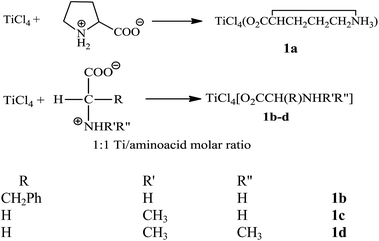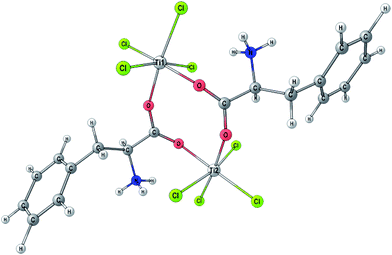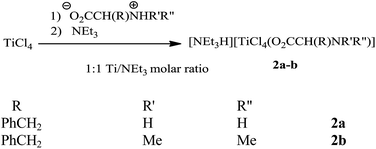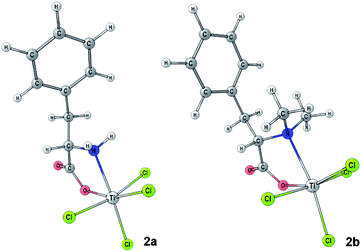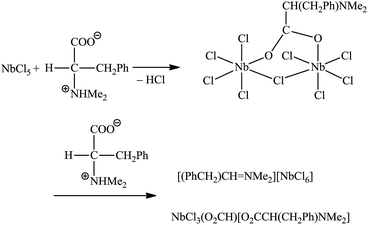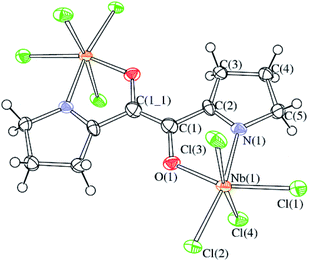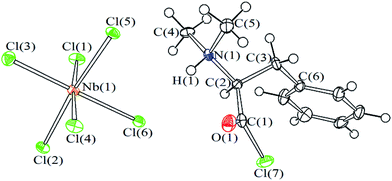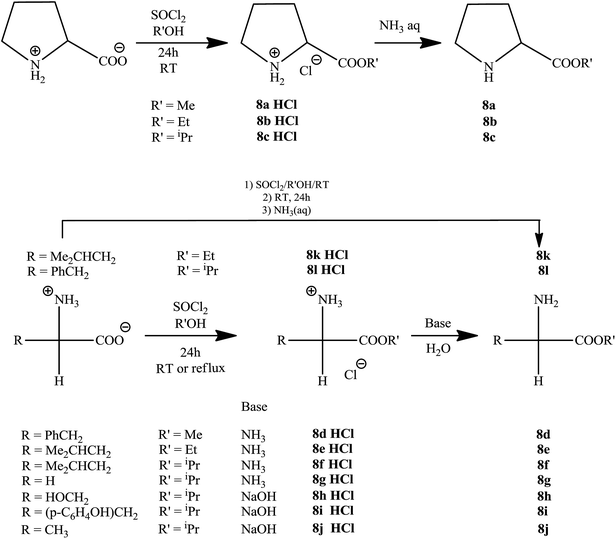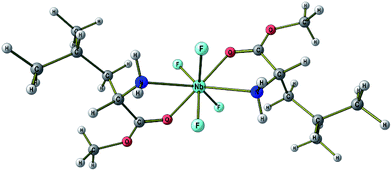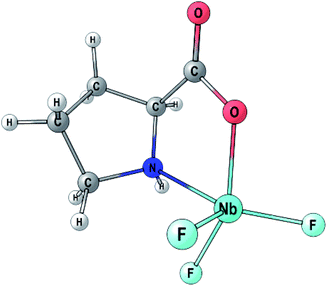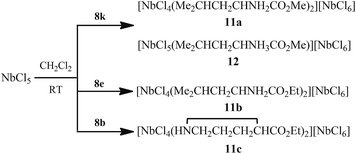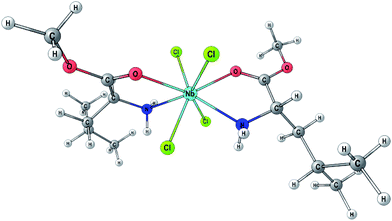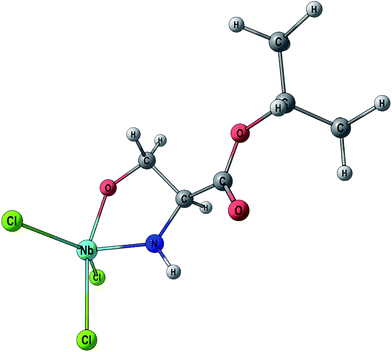 Open Access Article
Open Access ArticleThe reactions of α-amino acids and α-amino acid esters with high valent transition metal halides: synthesis of coordination complexes, activation processes and stabilization of α-ammonium acylchloride cations†
Lorenzo Biancalanaa,
Marco Bortoluzzib,
Eleonora Ferretti‡
a,
Mohammad Hayatifara,
Fabio Marchetti a,
Guido Pampaloni
a,
Guido Pampaloni *a and
Stefano Zacchini
*a and
Stefano Zacchini c
c
aUniversity of Pisa, Dipartimento di Chimica e Chimica Industriale, Via G. Moruzzi 13, I-56124 Pisa, Italy. E-mail: guido.pampaloni@unipi.it; Web: http://www.dcci.unipi.it/guido-pampaloni.html Tel: +39 050 2219221
bCa' Foscari University of Venice, Dipartimento di Scienze Molecolari e Nanosistemi, Via Torino 155, I-30175 Mestre, Venezia, Italy
cUniversity of Bologna, Dipartimento di Chimica Industriale “Toso Montanari”, Viale Risorgimento 4, I-40136 Bologna, Italy
First published on 6th February 2017
Abstract
Titanium tetrachloride smoothly reacted with a selection of α-amino acids (aaH) in CH2Cl2 affording yellow to orange solid coordination compounds, 1a–d, in 70–78% yields. The salts [NHEt3][TiCl4(aa)], 2a–b, were obtained from TiCl4/aaH/NEt3 (aa = L-phenylalanine, N,N-dimethylphenylalanine), in 60–65% yields. The complex  , 3, was isolated from the reaction of L-proline with NbCl5/NHiPr2, performed in CH2Cl2 at room temperature. The X-ray structure of 3 features a bridging (E)-1,2-bis(3,4-dihydro-2H-pyrrol-5-yl)ethene-1,2-diolate ligand, resulting from the unprecedented C–C coupling between two proline units. Unusually stable α-ammonium acyl chlorides were prepared by the reactions of PCl5/MCln (MCln = NbCl5, WCl6) with L-proline, N,N-dimethylphenylalanine, sarcosine and L-methionine. MX5 (M = Nb, Ta; X = F, Cl) reacted with L-leucine methylester and L-proline ethylester to give ionic coordination compounds, [MX4L2][MX6] (M = Nb, L = Me2CHCH2CH(NH2)CO2Me, X = F, 9; Cl, 11a; M = Nb, X = Cl,
, 3, was isolated from the reaction of L-proline with NbCl5/NHiPr2, performed in CH2Cl2 at room temperature. The X-ray structure of 3 features a bridging (E)-1,2-bis(3,4-dihydro-2H-pyrrol-5-yl)ethene-1,2-diolate ligand, resulting from the unprecedented C–C coupling between two proline units. Unusually stable α-ammonium acyl chlorides were prepared by the reactions of PCl5/MCln (MCln = NbCl5, WCl6) with L-proline, N,N-dimethylphenylalanine, sarcosine and L-methionine. MX5 (M = Nb, Ta; X = F, Cl) reacted with L-leucine methylester and L-proline ethylester to give ionic coordination compounds, [MX4L2][MX6] (M = Nb, L = Me2CHCH2CH(NH2)CO2Me, X = F, 9; Cl, 11a; M = Nb, X = Cl,  , 11c; Ta, 11d), in moderate to good yields. [NbCl5(Me2CHCH2CHNH3CO2Me)][NbCl6], 12, was isolated as a co-product of the reaction of NbCl5 with L-leucine isopropylester, and crystallographically characterized. The reaction of NbCl5 with L-serine isopropylester afforded NbCl3(OCH2CHNHCO2iPr), 13, in 66% yield. The activation of the ester O–R bond was observed in the reactions of L-leucine methyl ester with NbF5 and L-proline ethyl ester with MBr5 (M = Nb, Ta), these reactions proceeding with the release of EtF and EtBr, respectively. All the metal products were characterized by analytical and spectroscopic methods, while DFT calculations were carried out in order to provide insight into the structural and mechanistic aspects.
, 11c; Ta, 11d), in moderate to good yields. [NbCl5(Me2CHCH2CHNH3CO2Me)][NbCl6], 12, was isolated as a co-product of the reaction of NbCl5 with L-leucine isopropylester, and crystallographically characterized. The reaction of NbCl5 with L-serine isopropylester afforded NbCl3(OCH2CHNHCO2iPr), 13, in 66% yield. The activation of the ester O–R bond was observed in the reactions of L-leucine methyl ester with NbF5 and L-proline ethyl ester with MBr5 (M = Nb, Ta), these reactions proceeding with the release of EtF and EtBr, respectively. All the metal products were characterized by analytical and spectroscopic methods, while DFT calculations were carried out in order to provide insight into the structural and mechanistic aspects.
Introduction
α-Amino acids constitute a class of organic compounds arousing great interest in synthetic chemistry, in view of their easy availability and low toxicity,1 the typical presence of a stereogenic centre (making them suitable substrates for asymmetric catalysis)2 and the possibility of firmly coordinating metal ions.3The esterification of the carboxylic acid moiety is one of the most viable modifications of the α-amino acid skeleton, and indeed a good number of α-amino acid esters have been synthesized and employed with reference to several application fields.4 Metal complexes containing α-amino acid esters as ligands are especially relevant to bio-inorganic chemistry, being useful to the synthesis of peptides,5,6 as biological models,7 and as scaffolds for the development of new drugs.8 Furthermore, α-amino acids and α-amino acid ester metal complexes, being possible chiral sources,9 have found increasing attention as privileged, potential catalysts for environmentally friendly asymmetric syntheses.2h,10
It is noteworthy that the large majority of these studies refer to middle to late transition metals, whereas very little is known about the parallel chemistry with early transition metal compounds. In particular, the homoleptic halides of high valent elements (oxidation state ≥ 4) belonging to groups 4, 5 and 6, HVTMH, are strongly oxophilic species, usually very air sensitive and incompatible with water. This characteristic has probably discouraged the linking with an “opposite world”, i.e. the exploration of the reactivity with α-amino acids, which in turn exhibit high water affinity, and their simple derivatives such as α-amino acid esters.
As a matter of fact, the coordination chemistry of HVTMH with α-amino acid esters still remains an unexplored field of research, with the exception of a former synthetic study regarding MoCl5.11 Similarly, the only information available up to 2014 on the interaction of HVTMH with α-amino acids, in the absence of further reactants, is a note dealing with the reactivity of TiCl4 with glycine.12 In all of the cases, the structural characterization of the products relied on limited data.
Recently, in the framework of our interest in the chemistry of HVTMH with naturally occurring compounds,13 we have found that MoCl5 and WCl6 behave as chlorinating agents towards natural α-amino acids, affording fairly stable α-ammonium acylchloride salts.14
On the other hand, the interaction of MX5 (M = Nb, Ta; X = Cl, Br) with α-amino acids leads to dinuclear complexes containing bridging α-amino acidato ligands via HX release.15 Subsequent activation of the coordinated α-amino acidato moiety has been observed in mild conditions in some specific cases, leading to iminium salts.
Herein, we will present an extension of our study on the reactivity between α-amino acids and HVTMH, including the synthesis of TiCl4 derivatives, the unprecedented metal mediated C–C dimerization of a α-amino acid (L-proline) and the stabilization of otherwise reactive α-ammonium acylchloride cations. We will also describe some reactivity of α-amino acid ester with niobium and tantalum pentahalides.16,17 All the reactions were carried out in a weakly coordinating solvent (CH2Cl2) by using enantiopure L-organic reactants in case. The metal products were characterized by elemental analysis, IR and NMR spectroscopy, while DFT calculations assisted the structural characterization. A DFT study was performed also in order to shed some light on the NbCl5-directed unusual L-proline pseudo dimerization.
Results and discussion
Reactivity of MCln with α-amino acids
Compounds 1a–d were characterized by analytical and spectroscopic methods. The IR spectra (solid state) contain one medium and one strong intensity absorption in the range 1600–1400 cm−1. These two absorptions are due, respectively, to the asymmetric (νa) and the symmetric (νs) stretching vibrations of the carboxylato group. In general, the wavenumber difference (Δνa–s = νa − νs) is considered as a useful parameter to discriminate between monodentate, chelating, and bridging bidentate carboxylato ligands. Δνa–s values within the range 100 to 150 cm−1 are typical of either chelating or bridging bidentate carboxylates.18 In view of the IR data available for 1a–d, i.e. Δνa–s varies between 103 (1a) and 135 (1d) cm−1, and the DFT results (vide infra), we propose a bridging bidentate-coordination fashion. This implies that the amino acid ligand should be coordinated to titanium as a zwitterion. Accordingly, a broad IR absorption is observed at 3091 cm−1 in the IR spectrum of 1d, assigned to ammonium N–H stretching vibration.
The geometry proposed on the basis of spectroscopic data was supported by DFT calculations on the possible isomers of 1b. The dinuclear structure [TiCl4(μ-κ2O–O2CCH(CH2Ph)NH3)]2, depicted in Fig. 1, resulted meaningfully more stable than mononuclear structures (see Fig. S1 given as ESI†).
Compounds 1a–d display low solubility in common organic solvents. The NMR spectra were recorded in CD3CN, displaying single sets of resonances. The 1H NMR spectra exhibit broad resonances in the 7.7–7.0 ppm range, related to the uncoordinated ammonium group. The 13C-NMR spectra of the more soluble 1a–b show the resonance of the carboxylate carbon at 176.1 and 170.0 ppm, respectively. These values are similar to those reported for O,O-coordinated α-amino acids in NbCl5 derivatives.15
The coordination of organic species to high valent transition metal chlorides represents, in a number of cases, the preliminary step of some activation process.13c,19 The activation is favoured by the strong Lewis acidity of the metal centre, and may be triggered by the addition of a Brönsted base. For instance, Peryshkov and coworkers recently described a C–H bond activation reaction of nitriles by means of NEt3 upon coordination to TaCl5.20
Thus, the reaction of 1b with NEt3 proceeded with selective deprotonation of the ammonium group; analogous result was achieved by treatment of a TiCl4/L-N,N-dimethylphenylalanine mixture with NEt3 (Scheme 2).21 The reactions of 1a,c,d with NEt3 were not straightforward, leading to non identified compounds; the solid isolated from 1a/NEt3 revealed to be paramagnetic.
The CH2Cl2 soluble compounds 2a–b (Scheme 2) were isolated by addition of hexane to the respective reaction mixtures.22
The 1H NMR spectra of 2a–b display a low field resonance accounting for the triethylammonium proton (e.g. at 9.09 ppm in the case of 2a); the resonances of the N-bound protons within the anion undergo significant upfield shift on going from the amino acid unit in 1b to the amino acidate one in 2b (Δδ > 3 ppm). The IR spectra of 2a–b exhibit a strong absorption around 1700 cm−1: this evidence suggests O,N-coordination of the aminoacidate moiety, leaving a uncoordinated C![[double bond, length as m-dash]](https://www.rsc.org/images/entities/char_e001.gif) O bond. The geometries of the 2a,b anions were DFT optimized, on considering either mononuclear and dinuclear structures as starting points (Fig. S2†). Thus, mononuclear compounds bearing N,O-chelating α-aminoacidates (Fig. 2) resulted much more stable than dinuclear homologues (see ESI† for more details).
O bond. The geometries of the 2a,b anions were DFT optimized, on considering either mononuclear and dinuclear structures as starting points (Fig. S2†). Thus, mononuclear compounds bearing N,O-chelating α-aminoacidates (Fig. 2) resulted much more stable than dinuclear homologues (see ESI† for more details).
![[thin space (1/6-em)]](https://www.rsc.org/images/entities/char_2009.gif) :
:![[thin space (1/6-em)]](https://www.rsc.org/images/entities/char_2009.gif) 1 reactions of NbX5 (X = Cl, Br) with a variety of α-amino acids afforded dinuclear α-aminoacidate complexes via HCl release. The addition of a further equivalent of organic reactant resulted in the decarboxylation of one amino acidate moiety, with consequent formation of iminium salts and Nb-formate species (see Scheme 3, showing the specific case of N,N-dimethylphenylalanine).15
1 reactions of NbX5 (X = Cl, Br) with a variety of α-amino acids afforded dinuclear α-aminoacidate complexes via HCl release. The addition of a further equivalent of organic reactant resulted in the decarboxylation of one amino acidate moiety, with consequent formation of iminium salts and Nb-formate species (see Scheme 3, showing the specific case of N,N-dimethylphenylalanine).15
With the aim of exploring the possibility of further activation pathways, we investigated the reactions of Nb2Cl9(α-amino acidate) complexes with NEt3. In general, the amino acidate moiety did not undergo activation under these conditions, with an exception provided by the Nb2Cl9(L-prolinate)/NEt3 system. This latter evolved into a complicated mixture of products, including minor amounts of  , 3. The use of NHiPr2 in the place of NEt3 allowed to isolate red crystals of 3 (12% yield), and also yellow crystals of [NH2iPr2][NbCl6], 4 (40% yield), Scheme 4.
, 3. The use of NHiPr2 in the place of NEt3 allowed to isolate red crystals of 3 (12% yield), and also yellow crystals of [NH2iPr2][NbCl6], 4 (40% yield), Scheme 4.
The X-ray structure of 3 is shown in Fig. 3, with relevant bonding parameters listed in Table 1; the X-ray structure of 4 is given as ESI (Fig. S3; Tables S1A and S1B†).
| a Symmetry transformation used to generate C(1_1): −x + 1, −y, −z + 1. | |||
|---|---|---|---|
| Nb(1)–Cl(1) | 2.3319(13) | Nb(1)–Cl(2) | 2.2833(11) |
| Nb(1)–Cl(3) | 2.3454(12) | Nb(1)–Cl(4) | 2.3453(12) |
| Nb(1)–O(1) | 1.927(3) | Nb(1)–N(1) | 2.235(4) |
| C(1)–O(1) | 1.357(6) | C(1)–C(1_1) | 1.337(10) |
| C(1)–C(2) | 1.471(7) | C(2)–C(3) | 1.488(7) |
| C(3)–C(4) | 1.530(6) | C(4)–C(5) | 1.528(6) |
| N(1)–C(2) | 1.276(6) | N(1)–C(5) | 1.477(6) |
| Cl(1)–Nb(1)–O(1) | 158.18(10) | Cl(2)–Nb(1)–N(1) | 167.62(11) |
| Cl(3)–Nb(1)–Cl(4) | 170.32(5) | O(1)–Nb(1)–N(1) | 73.03(14) |
| Nb(1)–O(1)–C(1) | 122.9(3) | Nb(1)–N(1)–C(2) | 117.6(3) |
| Nb(1)–N(1)–C(5) | 132.0(3) | C(2)–N(1)–C(5) | 110.4(4) |
| N(1)–C(2)–C(3) | 115.8(4) | N(1)–C(2)–C(1) | 110.7(4) |
| C(1)–C(2)–C(3) | 133.5(4) | C(2)–C(3)–C(4) | 102.3(4) |
| C(3)–C(4)–C(5) | 105.8(4) | C(4)–C(5)–N(1) | 105.7(4) |
| O(1)–C(1)–C(2) | 114.6(4) | O(1)–C(1)–C(1_1) | 120.2(6) |
| C(2)–C(1)–C(1_1) | 125.2(6) | ||
Complex 3 displays crystallographic ![[1 with combining macron]](https://www.rsc.org/images/entities/char_0031_0304.gif) (Ci) symmetry with the inversion centre located on the middle of the C(1)–C(1_1) bond. The complex is composed of an unprecedented anionic
(Ci) symmetry with the inversion centre located on the middle of the C(1)–C(1_1) bond. The complex is composed of an unprecedented anionic  ligand (E-1,2-bis(3,4-dihydro-2H-pyrrol-5-yl)ethene-1,2-diolate) that is μ-κ2O,κ 2N-coordinated over two [NbCl4]+ cationic fragments. Such anionic ligand is almost perfectly planar (mean deviation from the least squares plane 0.0387 Å), being the two Nb atoms respectively 0.1879 Å above and below this plane. C(1), C(2) and N(1) [sum angles 360.0(9), 360.0(7) and 360.0(6)°, respectively] show a perfect sp2 hybridization, and the C(1)–C(1_1) [1.357(6) Å] and C(2)–N(1) [1.276(6) Å] distances are typical for double bonds.23
ligand (E-1,2-bis(3,4-dihydro-2H-pyrrol-5-yl)ethene-1,2-diolate) that is μ-κ2O,κ 2N-coordinated over two [NbCl4]+ cationic fragments. Such anionic ligand is almost perfectly planar (mean deviation from the least squares plane 0.0387 Å), being the two Nb atoms respectively 0.1879 Å above and below this plane. C(1), C(2) and N(1) [sum angles 360.0(9), 360.0(7) and 360.0(6)°, respectively] show a perfect sp2 hybridization, and the C(1)–C(1_1) [1.357(6) Å] and C(2)–N(1) [1.276(6) Å] distances are typical for double bonds.23
The {C2O2} core of the (E)-1,2-bis(3,4-dihydro-2H-pyrrol-5-yl)ethene-1,2-diolate ligand in 3 is a fully deprotonated 1,2-enediol. In general, 1,2-enediols are quite unstable species,24 whose stabilization may be supplied by hydrogen-bonded protons,25 or by chelating (N,O) coordination to transition metals.26
Basically, the process leading to 3 is a C–C bond forming condensation of two proline units (Scheme 5A). Differently, typical α-amino acid condensation generates a peptide bond (Scheme 5B).27
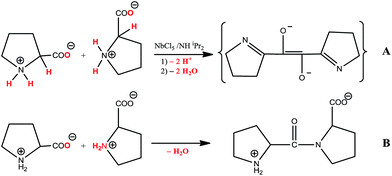 | ||
| Scheme 5 NbCl5-promoted C–C pseudo-dimerization of L-proline (A); peptide bond formation from two L-proline units (B). | ||
In order to gain some insight into the mechanism of the low yield formation of 3, a DFT study was undertaken (see Scheme S1 in the ESI†). It seems plausible that the C–C bond forming step consists in the coupling of two acylchloride units, accompanied by the release of HCl and assisted by the amine (see Scheme S1,† E → F → G). Indeed the side reactions NHiPr2 + HCl → [NH2iPr2]Cl and [NH2iPr2]Cl + NbCl5 → 4 should contribute to decrease the ΔG variation of the process leading to 3.
The crystals of 3 exhibited insufficient solubility in suitable deuterated solvents, thus preventing the NMR characterization.
Some of us recently reported13b,29 a straightforward and clean route to unusually stable salts of the acylchloride derivative of L-proline, by combination of the traditional PCl5-chlorinating reaction with the considerable stability imparted by the [MCl6]− (M = Nb, Ta) anions, Scheme 6.13b–c,30
We reckoned that the easily available [NbCl6]− anion could provide stability also to other unstable/unknown α-ammonium acylchloride cations (see above). Therefore, we tried to optimize and generalize the synthetic procedure shown in Scheme 6. When a dichloromethane 1![[thin space (1/6-em)]](https://www.rsc.org/images/entities/char_2009.gif) :
:![[thin space (1/6-em)]](https://www.rsc.org/images/entities/char_2009.gif) 1 molar mixture of PCl5 and NbCl5 was treated with L-N,N-dimethylphenylalanine or sarcosine,31 the subsequent 31P NMR analysis on the reaction solution evidenced the presence of POCl3 as prevalent phosphorous species [singlet at 6.2 ppm (from PCl5/NbCl5/L-N,N-dimethylphenylalanine) and 5.6 ppm (from PCl5/NbCl5/sarcosine), respectively].13b,29,32 The corresponding [NbCl6]− α-ammonium acylchloride salts, 5a–b, were isolated at room temperature in 40–50% yields (Scheme 7). The presence of [NbCl6]− in 5a–b was unambiguously detected by a typical 93Nb NMR resonance around 0 ppm.13c,33 The structure of 5a was determined by X-ray diffraction (Fig. 4, Table 2). It contains the [PhCH2CH(NHMe2)COCl]+ cation, which has never been reported heretofore. Within crystals of 5a, some intermolecular N–H⋯Cl hydrogen bonds are present involving the ammonium group of the cation as donor and the chloride ligands of the anion as an acceptor. The bonding parameters of the cation are comparable to those previously reported for other α-ammonium acylchloride salts.13b,14,29 Thus, the C(1)–O(1) distance [1.178(5) Å] corresponds to an almost pure double bond, whereas all the other contacts are typical for single bonds.34 The C(2) atoms displays an absolute S configuration with refined Flack parameter 0.03(2).35
1 molar mixture of PCl5 and NbCl5 was treated with L-N,N-dimethylphenylalanine or sarcosine,31 the subsequent 31P NMR analysis on the reaction solution evidenced the presence of POCl3 as prevalent phosphorous species [singlet at 6.2 ppm (from PCl5/NbCl5/L-N,N-dimethylphenylalanine) and 5.6 ppm (from PCl5/NbCl5/sarcosine), respectively].13b,29,32 The corresponding [NbCl6]− α-ammonium acylchloride salts, 5a–b, were isolated at room temperature in 40–50% yields (Scheme 7). The presence of [NbCl6]− in 5a–b was unambiguously detected by a typical 93Nb NMR resonance around 0 ppm.13c,33 The structure of 5a was determined by X-ray diffraction (Fig. 4, Table 2). It contains the [PhCH2CH(NHMe2)COCl]+ cation, which has never been reported heretofore. Within crystals of 5a, some intermolecular N–H⋯Cl hydrogen bonds are present involving the ammonium group of the cation as donor and the chloride ligands of the anion as an acceptor. The bonding parameters of the cation are comparable to those previously reported for other α-ammonium acylchloride salts.13b,14,29 Thus, the C(1)–O(1) distance [1.178(5) Å] corresponds to an almost pure double bond, whereas all the other contacts are typical for single bonds.34 The C(2) atoms displays an absolute S configuration with refined Flack parameter 0.03(2).35
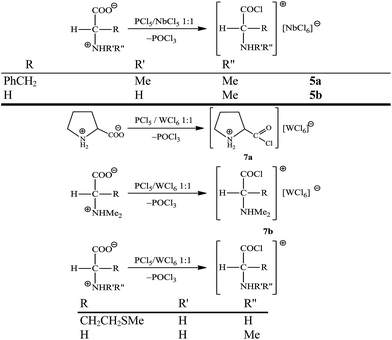 | ||
| Scheme 7 Formation of otherwise unstable α-ammonium acylchloride cations from α-amino acids and niobium and tungsten chlorides. | ||
| Nb(1)–Cl(1) | 2.3305(11) | Nb(1)–Cl(2) | 2.3344(11) |
| Nb(1)–Cl(3) | 2.2921(11) | Nb(1)–Cl(4) | 2.3475(11) |
| Nb(1)–Cl(5) | 2.3844(11) | Nb(1)–Cl(6) | 2.4206(11) |
| C(1)–Cl(7) | 1.758(5) | C(1)–O(1) | 1.178(5) |
| C(1)–C(2) | 1.516(7) | C(2)–C(3) | 1.553(6) |
| C(2)–N(1) | 1.500(6) | N(1)–C(4) | 1.499(5) |
| N(1)–C(5) | 1.501(6) | C(3)–C(6) | 1.516(6) |
| Cl(1)–Nb(1)–Cl(4) | 176.12(5) | Cl(2)–Nb(1)–Cl(5) | 174.25(5) |
| Cl(3)–Nb(1)–Cl(6) | 179.14(4) | O(1)–C(1)–Cl(7) | 120.6(4) |
| O(1)–C(1)–C(2) | 125.4(4) | Cl(7)–C(1)–C(2) | 113.9(3) |
| C(1)–C(2)–C(3) | 115.1(4) | C(1)–C(2)–N(1) | 107.3(4) |
| C(2)–C(3)–C(6) | 115.1(4) | C(2)–N(1)–C(4) | 111.4(3) |
| C(2)–N(1)–C(5) | 114.9(3) | C(4)–N(1)–C(5) | 111.4(4) |
The iminium salt [PhCH2![[double bond, length as m-dash]](https://www.rsc.org/images/entities/char_e001.gif) NMe2][NbCl6] (see Scheme 3) and the adduct NbCl5(O
NMe2][NbCl6] (see Scheme 3) and the adduct NbCl5(O![[double bond, length as m-dash]](https://www.rsc.org/images/entities/char_e001.gif) PCl3), 6, identified by comparison of the crystal cell data with those reported in the literature,36 were obtained as minor products from NbCl5/L-N,N-dimethylphenylalanine and NbCl5/sarcosine, respectively.
PCl3), 6, identified by comparison of the crystal cell data with those reported in the literature,36 were obtained as minor products from NbCl5/L-N,N-dimethylphenylalanine and NbCl5/sarcosine, respectively.
The synthetic approach leading to 5a–b exploits the M–Cl (M = P, Nb) bond energy scale,13b,37 making PCl5 a preferential chlorinating agent respect to NbCl5, and the stability of the [NbCl6]− anion. Similar considerations led us to test the PCl5/WCl6 mixture; it should be noted that anionic simple derivatives of WCl6 (i.e., WCl6, WOCl5−) have recently proposed as effective partners for the stabilization of otherwise reactive cations.14a,38
Hence, the reactions of PCl5/WCl6 (1![[thin space (1/6-em)]](https://www.rsc.org/images/entities/char_2009.gif) :
:![[thin space (1/6-em)]](https://www.rsc.org/images/entities/char_2009.gif) 1 mixture) with L-proline, L-N,N-dimethylphenylalanine, sarcosine and L-methionine proceeded with PCl5 to POCl3 conversion (31P NMR), and straightforwardly afforded the respective α-ammonium acylchloride cations (Scheme 7). According to elemental analyses and magnetic measurements,38 the cations were isolated in good yields as [WCl6]− salts, 7a–b, respectively from PCl5/WCl6/L-proline and PCl5/WCl6/L-N,N-dimethylphenylalanine. Otherwise, different anions were presumably associated with sarcosine and methionine derivatives, including [WOCl5]− (few crystals of [MeNH2CH2C(
1 mixture) with L-proline, L-N,N-dimethylphenylalanine, sarcosine and L-methionine proceeded with PCl5 to POCl3 conversion (31P NMR), and straightforwardly afforded the respective α-ammonium acylchloride cations (Scheme 7). According to elemental analyses and magnetic measurements,38 the cations were isolated in good yields as [WCl6]− salts, 7a–b, respectively from PCl5/WCl6/L-proline and PCl5/WCl6/L-N,N-dimethylphenylalanine. Otherwise, different anions were presumably associated with sarcosine and methionine derivatives, including [WOCl5]− (few crystals of [MeNH2CH2C(![[double bond, length as m-dash]](https://www.rsc.org/images/entities/char_e001.gif) O)Cl][WOCl5] were isolated and X-ray characterized) and W(IV) species.
O)Cl][WOCl5] were isolated and X-ray characterized) and W(IV) species.
The characterization of the 1![[thin space (1/6-em)]](https://www.rsc.org/images/entities/char_2009.gif) :
:![[thin space (1/6-em)]](https://www.rsc.org/images/entities/char_2009.gif) 1 mixture WCl6/PCl5 suggested that both chlorides remained intact when mixed together (see Experimental for details). This implies that the WCl6 to WCl6− reduction, as clearly observed in 7a–b, is promoted by the α-amino acid. Analogous WCl6 reduction has been previously observed in a number of cases by interaction with organic compounds.38,39
1 mixture WCl6/PCl5 suggested that both chlorides remained intact when mixed together (see Experimental for details). This implies that the WCl6 to WCl6− reduction, as clearly observed in 7a–b, is promoted by the α-amino acid. Analogous WCl6 reduction has been previously observed in a number of cases by interaction with organic compounds.38,39
All the α-ammonium acylchloride cations produced from PCl5/NbCl5 and PCl5/WCl6 were fully characterized by IR and NMR spectroscopy, and those cations derived from L-N,N-dimethylphenylalanine and L-methionine are reported here for the first time. The chloro-acyl moiety manifests itself by a strong IR absorption in the region 1765–1783 cm−1, other than the 13C NMR resonance in the range 169.0–171.7 ppm.
Reactivity of MCln with α-amino acid esters
 | ||
| Scheme 9 Coordination compounds from the reactions of NbF5 with L-proline ethylester and L-leucine methylester. | ||
Compound 9 can be viewed as a coordination compound resulting from the unsymmetrical rupture of the structure of NbF5 (a tetramer in the solid state17a).13c,42 The IR spectrum shows a strong absorption at 1648 cm−1, attributed to the stretching vibration of the C![[double bond, length as m-dash]](https://www.rsc.org/images/entities/char_e001.gif) O bond belonging to the ester function. The ca. 100 cm−1 shift to lower wavenumbers is in agreement with the coordination of the carbonyl moiety to niobium. The shift of the absorptions due to the stretching of the amino group from 3380 cm−1 (in 8k) to 3232 cm−1 (in 9) suggests that also the nitrogen atom is involved in the coordination to the metal centre. Accordingly, two low field 1H NMR resonances have been found for the NH2 group in 9 (δ = 8.6 and 7.0 ppm, CDCl3 solution). On the other hand, the same group gives raise to a singlet at 1.65 ppm in the 1H NMR spectrum of 8k.
O bond belonging to the ester function. The ca. 100 cm−1 shift to lower wavenumbers is in agreement with the coordination of the carbonyl moiety to niobium. The shift of the absorptions due to the stretching of the amino group from 3380 cm−1 (in 8k) to 3232 cm−1 (in 9) suggests that also the nitrogen atom is involved in the coordination to the metal centre. Accordingly, two low field 1H NMR resonances have been found for the NH2 group in 9 (δ = 8.6 and 7.0 ppm, CDCl3 solution). On the other hand, the same group gives raise to a singlet at 1.65 ppm in the 1H NMR spectrum of 8k.
In addition, the 19F and 93Nb NMR spectra (decet at 103 ppm and septet at −1553 ppm, respectively) are unequivocal fingerprints for the presence of the [NbF6]− anion in solution.13c,42,43
In conclusion, on considering the tendency of NbF5 to the unsymmetrical breaking of the Nb–F bridges, with formation of [NbF4]+ cations and [NbF6]− anions,42 analytical and spectroscopic data suggest that 9 is a salt containing an octacoordinate [NbF4(Me2CHCH2CHNH2CO2Me)2]+ cation, comprising two O,N-ligated α-amino acid esters, and a [NbF6]− anion. The coordination number of the cation was confirmed by DFT calculations, being six-coordinate geometries less stable by more than 30 kcal mol−1. The optimized geometry is shown in Fig. 5. DFT calculations with dichloromethane as implicit solvent also indicated that the [NbF4(Me2CHCH2CHNH2CO2Me)2][NbF6] salt is slightly more stable compared to its neutral isomer NbF5(Me2CHCH2CHNH2CO2Me). The metal centre in this last species should be eight-coordinated, the α-amino acid ester behaving as N,O-donor chelating ligand (Fig. S4†).
It worth noting that the majority of coordination complexes containing α-amino acid ester ligands are based on late transition metals (Ru, Os, Co, Rh, Pt, Zn).44 Only few examples are known with group 6 elements45 and also derivatives of group 4 and group 5 metals are very rare.
The reaction of NbF5 with L-proline ethyl ester, 8b, revealed a different outcome, and 10 was obtained under the same conditions employed for NbF5/8k. The use of Nb/8b molar ratio = 2 afforded 10 with the best yield (Scheme 9). Ethyl fluoride was NMR identified as a co-product of the reaction performed in CD2Cl2 in a closed tube, while L-proline was recovered after hydrolysis of the reaction mixture. These experimental facts support the presence in 10 of a carboxylato moiety originated from the cleavage of the ester function.
Compound 10 is a colourless solid whose salient spectroscopic features are two IR bands at 3381 cm−1 (N–H) and 1636 cm−1 (C![[double bond, length as m-dash]](https://www.rsc.org/images/entities/char_e001.gif) O), and 1H and 19F NMR resonances at 11.77 ppm (NH) and 100.9 ppm ([NbF6]−), respectively. These data suggest a bidentate N,O-coordination of the α-amino carboxylate ligand. Dinuclear geometries with the α-amino acidate as bridging ligand were ruled out by DFT calculations. The optimized geometry of the cation of 10 is depicted in Fig. 6 (see also Fig. S5 given as ESI†).
O), and 1H and 19F NMR resonances at 11.77 ppm (NH) and 100.9 ppm ([NbF6]−), respectively. These data suggest a bidentate N,O-coordination of the α-amino carboxylate ligand. Dinuclear geometries with the α-amino acidate as bridging ligand were ruled out by DFT calculations. The optimized geometry of the cation of 10 is depicted in Fig. 6 (see also Fig. S5 given as ESI†).
We extended the present study to the interaction of α-amino acid esters with the heavier niobium pentahalides. These reactions led to complicated mixtures of metal products, with presumable activation of the organic substrates. Only in a few cases, all involving the metal pentachlorides, a clean reaction pathway was observed (Scheme 10).
All the identified products, 11a–d and 12, are colourless to pale yellow solids, being scarcely soluble in organic solvents. Spectroscopic considerations discussed for 10 are valid also for 11a–d, thus suggesting the bidentate N,O coordination of two α-amino acid ester ligands to the same metal centre within a cation. The presence of the [NbCl6]− anion in 11a–c is the consequence of unsymmetrical cleavage of the dinuclear NbCl5 structure,13c,33,46 and was unambiguously evidenced by a sharp 93Nb NMR resonance occurring in the interval 4–13 ppm.13c,33
DFT calculations were carried out on the cation of 11a, considering either one or two α-amino acid esters in the niobium sphere. The coordination of another equivalent of the α-amino acid ester to [NbCl4(Me2CHCH2CHNH2CO2Me)]+ resulted a favourable process, being the associated ΔG variation around −25 kcal mol−1. The DFT-optimized geometry of [NbCl4(Me2CHCH2CHNH2CO2Me)2]+ is represented in Fig. 7.
A crop of X-ray quality crystals of 12 was obtained directly from the reaction mixture after separation from 11a. Compound 12 differs from the previous compounds as far as the solubility is concerned. Once isolated in the solid state, it does not dissolve again in common organic solvents.
Compound 12 consists of an ionic packing of [NbCl5(CH3)2CHCH2CHNH3CO2Me)]+ cations and [NbCl6]− anions. The cation is represented in Fig. 8, and the related bonding parameters are reported in Table 3. A view of the structure of the anion is given in Fig. S6,† the relevant bonding parameters being collected in Table S2A.† H-bonds between the NH3-group of the cation and the chlorides of [NbCl6]− are present within the crystals (see Table S2B† for details). Compound 12 crystallizes in the chiral space group P21 and the C(2) atom of the α-amino acid ester ligand displays S absolute configuration.
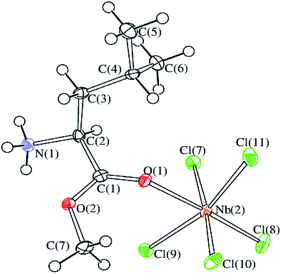 | ||
| Fig. 8 ORTEP drawing of the [NbCl5(CH3)2CHCH2CHNH3CO2Me)]+ cation in 12. The [NbCl6]− anion is reported in Fig. S6.† Displacement ellipsoids are at the 50% probability level. | ||
| Nb(2)–Cl(7) | 2.3555(9) | Nb(2)–Cl(8) | 2.2641(10) |
| Nb(2)–Cl(9) | 2.3318(10) | Nb(2)–Cl(10) | 2.3250(10) |
| Nb(2)–Cl(11) | 2.2918(9) | Nb(2)–O(1) | 2.209(2) |
| C(1)–O(1) | 1.231(4) | C(1)–O(2) | 1.291(4) |
| C(7)–O(2) | 1.473(3) | C(1)–C(2) | 1.499(4) |
| C(2)–N(1) | 1.506(4) | C(2)–C(3) | 1.534(4) |
| Cl(7)–Nb(2)–Cl(10) | 174.26(3) | Cl(9)–Nb(2)–Cl(11) | 163.09(3) |
| Cl(8)–Nb(2)–O(1) | 177.18(6) | Nb(2)–O(1)–C(1) | 145.2(2) |
| O(1)–C(1)–O(2) | 125.5(3) | O(1)–C(1)–C(2) | 121.0(3) |
| O(2)–C(1)–C(2) | 113.5(3) | C(1)–C(2)–C(3) | 112.3(3) |
| C(1)–C(2)–N(1) | 109.4(2) | N(1)–C(2)–C(3) | 108.4(3) |
The source of protonation leading to 12 is not clear, being possibly the result of some activation of the organic reactant promoted by the strongly acidic niobium chloride. Nevertheless, the occurrence of fortuitous hydrolysis might play some role and should not be ruled out.
12 represents the second crystallographically characterized example where a cationic α-amino acid ester is coordinated to any metal centre, and the first one where the coordination occurs via oxygen. In fact, previous to this work, only the structure of a Ru(II) complex containing a η6-bonded L-phenylalaninium methyl ester was reported.47 More commonly, α-amino acid esters act as ligands in the neutral form RCHNH2CO2R′, via the N-atom or both N and O.44,45
We moved to study the reaction of NbCl5 with L-serine isopropylester, 8h, i.e. a α-amino acid ester bearing a peripheral OH group and potentially acting as a pincer ligand. The 1![[thin space (1/6-em)]](https://www.rsc.org/images/entities/char_2009.gif) :
:![[thin space (1/6-em)]](https://www.rsc.org/images/entities/char_2009.gif) 1 reaction of NbCl5 and 8h in refluxing chloroform led to the formation of NbCl3(OCHCH2NHCOOiPr), 13, as a colourless precipitate. The ν(C
1 reaction of NbCl5 and 8h in refluxing chloroform led to the formation of NbCl3(OCHCH2NHCOOiPr), 13, as a colourless precipitate. The ν(C![[double bond, length as m-dash]](https://www.rsc.org/images/entities/char_e001.gif) O) stretching band in 13 (1732 cm−1) is only slightly shifted respect to 8h (1728 cm−1), thus indicating that the ester group is not involved in coordination.
O) stretching band in 13 (1732 cm−1) is only slightly shifted respect to 8h (1728 cm−1), thus indicating that the ester group is not involved in coordination.
Compound 13 showed a single set of signals in 1H and 13C NMR spectra (in CD3CN); 1H resonances are shifted to higher ppm values with respect to 8h [most notably δ(NH) from 2.6 ppm in 8h to 7.0 ppm in 13], while 13C resonances are shifted to lower ppm values [e.g., δ(CO) from 175 ppm in 8h to 167 ppm in 13].
At variance to the other α-amino acid ester complexes of niobium in this work, compound 13 is a neutral species in solution with a single 93Nb resonance at −493 ppm. DFT calculations suggest a mononuclear structure (Fig. 9) as the most probable geometry. A positive Gibbs energy variation (about 3.5 kcal mol−1) is accompanied to the dimerization of this species to the dinuclear form (see Fig. S7 and S8† for more details).
We could not cleanly isolate metal products from MBr5/α-amino acid ester (M = Nb, Ta). However, NMR investigations outlined the release of ethyl bromide from L-proline ethylester, in the presence of MBr5 (see Experimental for details).
Conclusions
The reactions of TiCl4 with a series of α-amino acids do not proceed with HCl release, in spite of the Lewis acidic character of the metal centre, and afford dinuclear coordination compounds containing zwitterionic ligands. Deprotonation of the ammonium function may be easily promoted by the addition of triethylamine, resulting in a modification of the coordination fashion of the α-amino acidic frame. On the other hand, the interaction of L-proline with NbCl5/NHEt2 has provided the first example of C–C bond forming self-condensation of a α-amino acid, although in modest yield. The overall transformation may be regarded as a Lewis acid induced intramolecular redox reaction, in which the carboxylate group is reduced and the pyrrolidine ring is oxidized. The combination of NbCl5 or WCl6 with the chlorinating power of PCl5 has been exploited to develop a simple synthetic method affording isolable salts of otherwise unstable α-ammonium acylchloride cations. α-Amino acid esters usually behave as bidentate O,N-ligands towards niobium and tantalum pentahalides, however activation of the ester function with release of alkyl halides has been observed in some cases.Experimental
General
Warning: all the metal products reported in this paper are highly moisture-sensitive, thus rigorously anhydrous conditions were required for the reaction and crystallization procedures. The reaction vessels were oven dried at 140 °C prior to use, evacuated (10−2 mmHg) and then filled with argon. TiCl4, NbX5 (X = F, Cl), PCl5 and WCl6 were purchased from Strem (>98% purity) and stored in sealed tubes under argon atmosphere. NbBr5 and TaBr5 were prepared according to literature procedures and stored under argon atmosphere.48 Once isolated, the metal products were conserved in sealed glass tubes under argon. The organic reactants were commercial products (Sigma-Aldrich) stored under argon atmosphere as received. Solvents (Sigma-Aldrich) were distilled before use from appropriate drying agents. Chromatographic purification of organic products was carried out on columns of deactivated alumina (4% w/w water). Infrared spectra were recorded at 298 K on a FT IR-Perkin Elmer Spectrometer, equipped with a UATR sampling accessory. NMR spectra were recorded at 293 K on a Bruker Avance II DRX400 instrument equipped with a BBFO broadband probe. The chemical shifts for 1H and 13C were referenced to the non-deuterated aliquot of the solvent; the chemical shifts for 93Nb were referenced to external [NEt4][NbCl6]; the chemical shifts for 19F were referenced to external CFCl3. Conductivity measurement was carried out using an Eutech Con 700 instrument (cell constant = 1.0 cm−1).49 Magnetic susceptibilities (reported per W atom) were measured on solid samples at 298 K with a Magway MSB Mk1 magnetic susceptibility balance (Sherwood Scientific Ltd). Diamagnetic corrections were introduced according to König.50 Carbon, hydrogen and nitrogen analyses were performed on a Carlo Erba mod. 1106 instrument. The chloride/bromide content was determined by the Mohr method51 on solutions prepared by dissolution of the solids in aqueous KOH and heated at boiling temperature for 72 hours, followed by cooling to room temperature and addition of HNO3 up to neutralization. Titanium, niobium and tantalum were analyzed, respectively, as TiO2 and M2O5 (M = Nb, Ta), obtained by hydrolysis of the samples followed by calcination in a platinum crucible.Reactions of TiCl4 with α-amino acids: synthesis of TiCl4(aa) (aa = L-proline, 1a; L-phenylalanine, 1b; sarcosine, 1c; N,N-dimethylglycine, 1d)
TiCl4(L-proline), 1a. Yellow solid, yield 321 mg (70%). Anal. calcd for C5H9Cl4NO2Ti: C, 19.70; H, 2.98; N, 4.60; Cl, 46.52; Ti, 15.70. Found: C, 19.39; H, 3.09; N, 4.52; Cl, 45.88; Ti, 15.89. IR (solid state): ν = 3219 mw, 2962 w, 1570 m, 1544 vs, 1441 vs, 1367 m, 1331 ms, 1260 m, 1081 m, 1031 ms, 798 s cm−1. 1H NMR (CD3CN): δ = 7.46, 7.15 (br, 2H, NH2); 4.53 (br, 1H, NCH); 3.54, 3.45, 2.42, 2.20, 2.06 (br, 6H, CH2) ppm. 13C NMR (CD3CN): δ = 176.1 (OCO); 61.6 (CH); 47.6, 28.6, 23.7 (CH2) ppm.
TiCl4(L-phenylalanine), 1b. Light orange solid, yield 388 mg (73%). Anal. calcd for C9H11Cl4NO2Ti: C, 30.46; H, 3.12; N, 3.95; Cl, 39.96; Ti, 13.49. Found: C, 30.60; H, 3.02; N, 4.13; Cl, 39.40; Ti, 13.28. IR (solid state): ν = 3030 m-br, 1600 m, 1558 vs, 1445 vs-br, 1336 m, 1047 w, 744 m, 698 ms cm−1. 1H NMR (CD3CN): δ = 7.39–7.30, 6.98 (8H, Ph + NH3); 4.46 (m, 1H, CH); 3.28 (m, 2H, CH2) ppm. 13C NMR (CD3CN): δ = 170.0 (OCO); 134.1 (ipso-Ph); 129.8, 129.2, 127.9 (C6H5); 61.8 (CH); 35.3 (CH2) ppm.
TiCl4(sarcosine), 1c. Yellow solid, yield 448 mg (78%). Anal. calcd for C3H7Cl4NO2Ti: C, 12.93; H, 2.53; N, 5.02; Cl, 50.87; Ti, 17.17. Found: C, 13.02; H, 2.43; N, 4.98; Cl, 36.23; Ti, 12.80. IR (solid state): ν = 3185 m, 2930 vw, 2810 vw, 1575 ms, 1561 vs, 1454 s, 1429 w, 1409 ms, 937 w, 792 s, 689 m-w cm−1. 1H NMR (CD3CN): δ = 7.26, 7.00 (br, 2H, NH2); 4.03 (br, 2H, CH2); 2.81 (br, 3H, CH3) ppm.
TiCl4(N,N-dimethylglycine), 1d. Yellow solid, yield 312 mg (71%). Anal. calcd for C4H9Cl4NO2Ti: C, 16.41; H, 3.10; N, 4.78; Cl, 48.43; Ti, 16.35. Found: C, 16.29; H, 3.17; N, 4.91; Cl, 48.26; Ti, 16.57. IR (solid state): ν = 3091 m-w, 2983 w, 1573 vs, 1438 s, 1401 m, 1364 s, 1324 m, 1142 m-w, 932 m-w, 857 m, 716 m cm−1. 1H NMR (CD3CN): δ = 7.7 (br, 1H, NH); 4.09 (br, 2H, CH2); 3.01 (br, 6H, CH3) ppm.
Reactions of TiCl4 with α-amino acid/NEt3: synthesis of [NHEt3][TiCl4(aa)] (aa = L-phenylalanine, 2a; N,N-dimethylphenylalanine, 2b)
[NHEt3][TiCl4(L-phenylalanine)], 2a. Light brown solid, yield 297 mg (65%). Anal. calcd for C15H26Cl4N2O2Ti: C, 39.50; H, 5.75; N, 6.14; Cl, 39.50; Ti, 10.50. Found: C, 39.33; H, 5.87; N, 6.16; Cl, 39.19; Ti, 10.61. IR (solid state): ν = 3306 w, 3240 w-br, 2984 w-br, 2675 w-br, 2488 w-br, 1691 vs, 1652 vs, 1568 s, 1454 s, 1228 m, 1099 m-s, 1070 m-s, 749 vs, 702 s cm−1. 1H NMR (CD2Cl2): δ = 9.09 (s, 1H, NH); 7.39–7.30 (5H, Ph); 4.38 (m, 1H, CH); 4.13, 3.62 (br, 2H, NH2); 3.26 (m, 6H, NCH2); 3.40, 3.17 (dd, 2H, CH2Ph); 1.40 (t, 3JHH = 7.34 Hz, 9H, NCH2CH3) ppm. 13C NMR (CD2Cl2): δ = 179.5 (OCO); 135.9 (ipso-Ph); 129.4, 129.2, 127.5 (Ph); 61.7 (CH); 47.1 (NCH2); 38.6 (CH2Ph); 9.0 (NCH2CH3) ppm.
[NHEt3][TiCl4(L-N,N-dimethylphenylalanine)], 2b. Yellow solid, yield 290 mg (60%). Anal. calcd for C17H30Cl4N2O2Ti: C, 42.18; H, 6.25; N, 5.79; Cl, 29.29; Ti, 9.89. Found: C, 42.36; H, 6.08; N, 5.65; Cl, 29.41; Ti, 9.72. IR (solid state): ν = 3260 w-br, 2963 w-br, 2679 w-br, 1702 s, 1660 vs, 1581 vs, 1454 vs, 1260 m, 1012 s, 741 s, 699 s cm−1. 1H NMR (CD2Cl2): δ = 8.0 (br, 1H, NH); 7.36–7.26 (5H, Ph); 4.47 (m, 1H, CH); 3.32 (m, 6H, NCH2); 3.19, 3.07 (m, 2H, CH2Ph); 2.95, 2.73 (s, 6H, NMe2); 1.42 (t, 3JHH = 7.34 Hz, 9H, NCH2CH3) ppm. 13C NMR (CD2Cl2): δ = 178.8 (OCO); 138.9 (ipso-Ph); 129.9, 129.2, 128.6, 126.6 (Ph); 75.6 (CH); 50.9, 47.6 (NMe2); 47.5 (NCH2); 30.8 (CH2Ph); 8.9 (NCH2CH3) ppm.
Reaction of NbCl5 with L-proline/NHiPr2: synthesis and isolation of  , 3, and [NH2iPr2][NbCl6], 4
, 3, and [NH2iPr2][NbCl6], 4
NbCl5 (0.385 g, 1.42 mmol) and L-proline (0.163 g, 1.42 mmol) were allowed to react in CH2Cl2 (20 mL). The solution was repetitiously purged with nitrogen gas in order to remove released HCl. After six hours, the yellowish mixture was treated with NHiPr2 (0.203 mL, 1.45 mmol), then the stirring was prolonged for additional 20 min. The final dark-red mixture was filtered off in order to remove a minor amount of solid, layered with hexane and settled aside at −30 °C. Red crystals of 3 were recovered after 48 h. Yield 56 mg, 12%. Anal. calcd for C10H12Cl8N2Nb2O2: C, 18.15; H, 1.83; N, 4.23; Cl, 42.86. Found: C, 18.43; H, 1.63; N, 4.51; Cl, 43.12. IR (solid state): ν = 1580 m-s (νC![[double bond, length as m-dash]](https://www.rsc.org/images/entities/char_e001.gif) N), 1183 m-s (νC–O) cm−1.
N), 1183 m-s (νC–O) cm−1.
The mother liquors were dried in vacuo, hence the residue was dissolved into CHCl3 (10 mL). The solution was layered with pentane and settled aside at −30 °C, thus 4 was isolated as a yellow-orange crystals after 48 h. Yield 238 mg, 40%. Anal. calcd for C7H16Cl6NNb: C, 20.03; H, 3.84; N, 3.34; Cl, 50.67. Found: C, 19.84; H, 3.75; N, 3.20; Cl, 49.95. IR (solid state): ν = 3130 s-br, 3080 s-br, 2987 w-m, 1606 m, 1565 m, 1424 m cm−1. 1H NMR (CD3CN): δ = 6.30 (br, 1H, NH); 3.48 (m, 2H, CH); 1.31 (m, 12H, Me) ppm. 13C NMR (CD3CN): δ = 47.7 (CH); 18.2 (Me) ppm. 93Nb NMR (CD3CN): δ = −0.2 (Δν½ = 95 Hz) ppm.
Reactions of α-amino acids with PCl5/NbCl5: synthesis of [(R)(Me)NHCH(R′)C(O)Cl][NbCl6] (R = Me, R′ = CH2Ph, 5a; R = R′ = H, 5b)
![[double bond, length as m-dash]](https://www.rsc.org/images/entities/char_e001.gif) PCl3), 6, were obtained from PCl5/NbCl5/L-N,N-dimethylphenylalanine and PCl5/NbCl5/sarcosine, respectively.
PCl3), 6, were obtained from PCl5/NbCl5/L-N,N-dimethylphenylalanine and PCl5/NbCl5/sarcosine, respectively.
[Me2NHCH(CH2Ph)C(O)Cl][NbCl6], 5a. Orange solid, yield 214 mg (47%) from PCl5/NbCl5/L-N,N-dimethylphenylalanine. Anal. calcd for C11H15Cl7NNbO: C, 25.49; H, 2.92; N, 2.70; Cl, 47.88; Nb, 17.92. Found: C, 25.23; H, 2.80; N, 2.67; Cl, 47.60; Nb, 18.10. IR (solid state): ν = 3087 w-m, 3029 w, 2939 w, 1767 vs (νC
![[double bond, length as m-dash]](https://www.rsc.org/images/entities/char_e001.gif) O), 1460 s, 1440 m, 1411 w, 1374 w, 1340 w, 1287 w, 1198 w, 1172 w, 1138 w, 1078 w, 1033 m, 1016 w, 991 w-m, 936 m, 917 w, 896 vs, 839 m, 820 w, 745 m, 726 vs, 693 vs cm−1. 1H NMR (CD2Cl2): δ = 7.68 (br, 1H, NH); 7.47–7.35 (m, 5H, Ph); 4.83 (s, 1H, CH); 3.62 (m, 2H, CH2); 3.34, 3.22 (s, 6H, NMe2) ppm. 13C NMR (CD2Cl2): δ = 170.6 (C
O), 1460 s, 1440 m, 1411 w, 1374 w, 1340 w, 1287 w, 1198 w, 1172 w, 1138 w, 1078 w, 1033 m, 1016 w, 991 w-m, 936 m, 917 w, 896 vs, 839 m, 820 w, 745 m, 726 vs, 693 vs cm−1. 1H NMR (CD2Cl2): δ = 7.68 (br, 1H, NH); 7.47–7.35 (m, 5H, Ph); 4.83 (s, 1H, CH); 3.62 (m, 2H, CH2); 3.34, 3.22 (s, 6H, NMe2) ppm. 13C NMR (CD2Cl2): δ = 170.6 (C![[double bond, length as m-dash]](https://www.rsc.org/images/entities/char_e001.gif) O); 130.7, 130.0, 129.2 (Ph); 127.7 (ipso-Ph); 76.5 (CH); 44.4, 43.4 (NMe2); 34.6 (CH2) ppm. 93Nb NMR (CD2Cl2): δ = 8.1 (Δν½ = 3·102 Hz) ppm.
O); 130.7, 130.0, 129.2 (Ph); 127.7 (ipso-Ph); 76.5 (CH); 44.4, 43.4 (NMe2); 34.6 (CH2) ppm. 93Nb NMR (CD2Cl2): δ = 8.1 (Δν½ = 3·102 Hz) ppm.
[MeNH2CH2C(O)Cl][NbCl6], 5b. Yellow solid, yield 144 mg (43%) from PCl5/NbCl5/sarcosine. Anal. calcd for C3H7Cl7NNbO: C, 8.70; H, 1.70; N, 3.38; Cl, 59.92; Nb, 22.43. Found: C, 8.80; H, 1.59; N, 3.31; Cl, 59.60; Nb, 22.55. IR (solid state): ν = 3138 m-s (νN–H), 2983 w, 2943 w, 1766 vs (νC
![[double bond, length as m-dash]](https://www.rsc.org/images/entities/char_e001.gif) O), 1546 w-m, 1454 m, 1430 m, 1414 m, 1397 vs, 1341 m, 1160 m, 1129 w, 1036 m, 999 vs, 926 vs, 789 vs, 767 vs cm−1. 1H NMR (CD3CN): δ = 7.42 (br, 2H, NH2); 4.67 (t, 2H, 4JHH = 5.38 Hz, CH2); 3.21 (q, 3H, 4JHH = 5.38 Hz, Me) ppm. 13C NMR (CD3CN): δ = 169.0 (C
O), 1546 w-m, 1454 m, 1430 m, 1414 m, 1397 vs, 1341 m, 1160 m, 1129 w, 1036 m, 999 vs, 926 vs, 789 vs, 767 vs cm−1. 1H NMR (CD3CN): δ = 7.42 (br, 2H, NH2); 4.67 (t, 2H, 4JHH = 5.38 Hz, CH2); 3.21 (q, 3H, 4JHH = 5.38 Hz, Me) ppm. 13C NMR (CD3CN): δ = 169.0 (C![[double bond, length as m-dash]](https://www.rsc.org/images/entities/char_e001.gif) O); 58.2 (CH2); 35.9 (Me) ppm. 93Nb NMR (CD3CN): δ = 0.1 (Δν½ = 31 Hz) ppm.
O); 58.2 (CH2); 35.9 (Me) ppm. 93Nb NMR (CD3CN): δ = 0.1 (Δν½ = 31 Hz) ppm.
Reactions of α-amino acids with PCl5/WCl6: synthesis of [NH2(CH2)3CHC(O)Cl][WCl6], 7a, [Me2NHCH(CH2Ph)C(O)Cl][WCl6], 7b, and [(R)NH2CH(R′)C(O)Cl]+ (R = Me, R′ = H; R = H, R′ = CH2CH2SMe)
In a different experiment, a 1![[thin space (1/6-em)]](https://www.rsc.org/images/entities/char_2009.gif) :
:![[thin space (1/6-em)]](https://www.rsc.org/images/entities/char_2009.gif) 1 PCl5/WCl6 mixture obtained in CD2Cl2 (3 mL) was analyzed. ΛM (CD2Cl2) = 0.3 S cm2 mol−1. 31P NMR (CD2Cl2): δ = −81.1 (PCl5) ppm. Cl analysis was carried out on the solid residue obtained by removal of the volatiles in vacuo. Anal. calcd for Cl11PW: Cl, 64.48. Found: Cl, 63.91. Magnetic measurement: diamagnetic.
1 PCl5/WCl6 mixture obtained in CD2Cl2 (3 mL) was analyzed. ΛM (CD2Cl2) = 0.3 S cm2 mol−1. 31P NMR (CD2Cl2): δ = −81.1 (PCl5) ppm. Cl analysis was carried out on the solid residue obtained by removal of the volatiles in vacuo. Anal. calcd for Cl11PW: Cl, 64.48. Found: Cl, 63.91. Magnetic measurement: diamagnetic.
[NH2(CH2)3CHC(O)Cl][WCl6], 7a. Green solid, yield 302 mg (73%) from PCl5/WCl6/L-proline. Anal. calcd for C5H9Cl7NOW: C, 11.31; H, 1.71; N, 2.64; Cl, 46.72. Found: C, 11.20; H, 1.78; N, 2.50; Cl, 46.33. IR (solid state): ν = 3133 m (νN–H), 3073 m, 2955 w, 1768 vs (νC
![[double bond, length as m-dash]](https://www.rsc.org/images/entities/char_e001.gif) O), 1563 m, 1455 w, 1375 w-m, 1343 w-m, 1079 w, 1043 m, 996 vs, 942 m, 906 w, 864 m cm−1. 1H NMR (CD3CN): δ = 7.36 (t, 2H, 3JHH = 50 Hz, NH2); 4.80 (m, 1H, CH); 3.45 (m, 2H, NCH2); 2.60, 2.36 (m, 2H, CH2); 2.14–2.06 ppm (m, 2H, CH2) ppm. 13C NMR (CD3CN): δ = 171.7 (C
O), 1563 m, 1455 w, 1375 w-m, 1343 w-m, 1079 w, 1043 m, 996 vs, 942 m, 906 w, 864 m cm−1. 1H NMR (CD3CN): δ = 7.36 (t, 2H, 3JHH = 50 Hz, NH2); 4.80 (m, 1H, CH); 3.45 (m, 2H, NCH2); 2.60, 2.36 (m, 2H, CH2); 2.14–2.06 ppm (m, 2H, CH2) ppm. 13C NMR (CD3CN): δ = 171.7 (C![[double bond, length as m-dash]](https://www.rsc.org/images/entities/char_e001.gif) O); 68.3 (CH); 48.4 (NCH2); 29.1, 23.7 ppm (CH2) ppm. Magnetic measurement: χcorrM = 3.60 × 10−4 cgsu, μeff = 0.93 BM.
O); 68.3 (CH); 48.4 (NCH2); 29.1, 23.7 ppm (CH2) ppm. Magnetic measurement: χcorrM = 3.60 × 10−4 cgsu, μeff = 0.93 BM.
[Me2NHCH(CH2Ph)C(O)Cl][WCl6], 7b. Dark yellow – brown solid, yield 285 mg (60%) from PCl5/WCl6/L-N,N-dimethylphenylalanine. Anal. calcd for C11H15Cl7NOW: C, 21.69; H, 2.48; N, 2.30; Cl, 40.73. Found: C, 21.78; H, 2.35; N, 2.20; Cl, 40.32. IR (solid state): ν = 3122 m-br, 3073 m, 2987 w-m, 2946 w, 2789 w, 1783 vs (νC
![[double bond, length as m-dash]](https://www.rsc.org/images/entities/char_e001.gif) O), 1564 w, 1455 m, 1433 w-m, 1400 m, 1347 w, 1260 w, 1164 w-m, 1041 w, 1001 s, 952 m, 930 m, 857 s, 802 s, 774 s cm−1. 1H NMR (CD2Cl2): δ = 7.74 (br, 1H, NH); 7.49–7.39 (m, 5H, Ph); 4.66 (br, 1H, CH); 3.62 (m-br, 2H, CH2); 3.31, 3.19 (s, 6H, NMe2) ppm. 13C NMR (CD2Cl2): δ = 170.8 (C
O), 1564 w, 1455 m, 1433 w-m, 1400 m, 1347 w, 1260 w, 1164 w-m, 1041 w, 1001 s, 952 m, 930 m, 857 s, 802 s, 774 s cm−1. 1H NMR (CD2Cl2): δ = 7.74 (br, 1H, NH); 7.49–7.39 (m, 5H, Ph); 4.66 (br, 1H, CH); 3.62 (m-br, 2H, CH2); 3.31, 3.19 (s, 6H, NMe2) ppm. 13C NMR (CD2Cl2): δ = 170.8 (C![[double bond, length as m-dash]](https://www.rsc.org/images/entities/char_e001.gif) O); 131.3, 130.0, 129.9, 129.2 (Ph); 78.3 (CH); 50.2, 48.1 (NMe2); 36.7 (CH2) ppm. Magnetic measurement: χcorrM = 4.02 × 10−4 cgsu, μeff = 0.98 BM.
O); 131.3, 130.0, 129.9, 129.2 (Ph); 78.3 (CH); 50.2, 48.1 (NMe2); 36.7 (CH2) ppm. Magnetic measurement: χcorrM = 4.02 × 10−4 cgsu, μeff = 0.98 BM.
[MeNH2CH2C(O)Cl]+. Green solid, from PCl5/WCl6/sarcosine. IR (solid state): ν = 3104 m-br (νN–H), 2980 w, 2938 w, 2796 w, 1765 vs (νC
![[double bond, length as m-dash]](https://www.rsc.org/images/entities/char_e001.gif) O), 1562 w-m, 1455 m, 1431 m, 1406 m, 1345 w-m, 1165 w-m, 1136 w, 1037 w, 1009 s, 991 vs, 951 m, 929 vs, 854 s, 806 vs, 773 vs, 728 s cm−1. 1H NMR (CD3CN): δ = 7.29 (br, 2H, NH2); 4.58 (s, 2H, CH2); 3.21 (s, 3H, Me) ppm. 13C NMR (CD3CN): δ = 169.0 (C
O), 1562 w-m, 1455 m, 1431 m, 1406 m, 1345 w-m, 1165 w-m, 1136 w, 1037 w, 1009 s, 991 vs, 951 m, 929 vs, 854 s, 806 vs, 773 vs, 728 s cm−1. 1H NMR (CD3CN): δ = 7.29 (br, 2H, NH2); 4.58 (s, 2H, CH2); 3.21 (s, 3H, Me) ppm. 13C NMR (CD3CN): δ = 169.0 (C![[double bond, length as m-dash]](https://www.rsc.org/images/entities/char_e001.gif) O); 63.2 (CH2); 40.4 (Me) ppm. Magnetic measurement: χcorrM = 1.13 × 10−3 cgsu.
O); 63.2 (CH2); 40.4 (Me) ppm. Magnetic measurement: χcorrM = 1.13 × 10−3 cgsu.
[NH3CH(CH2CH2SMe)C(O)Cl]+. Brown solid, from PCl5/WCl6/L-methionine. IR (solid state): ν = 3350 w-m (νN–H), 3008 w, 2921 w, 1779 s (νC
![[double bond, length as m-dash]](https://www.rsc.org/images/entities/char_e001.gif) O), 1569 w, 1480 w, 1449 w-m, 1415 m, 1367 w-m, 1309 w, 1263 w, 1176 w, 1144 w, 1094 w, 1025 m, 964 vs, 897 s, 759 s, 733 m, 699 w, 661 w cm−1. Magnetic measurement: χcorrM = 7.08 × 10−4 cgsu.
O), 1569 w, 1480 w, 1449 w-m, 1415 m, 1367 w-m, 1309 w, 1263 w, 1176 w, 1144 w, 1094 w, 1025 m, 964 vs, 897 s, 759 s, 733 m, 699 w, 661 w cm−1. Magnetic measurement: χcorrM = 7.08 × 10−4 cgsu.
Synthesis of α-amino acid ester hydrochlorides
These compounds were obtained by a slight modification of the literature procedures.L-Proline methylester hydrochloride, 8a·HCl40a,b. Colourless solid, yield 97%. IR (liquid film): ν = 3115 w (νN–H), 3021 w (νN–H), 2805 m, 1755 vs (νC
![[double bond, length as m-dash]](https://www.rsc.org/images/entities/char_e001.gif) O), 1634 m, 1442 m, 1391 m-s, 1089 m, 1015 m cm−1. 1H NMR (CDCl3): δ = 10.68, 9.04 (br, 2H, NH2); 4.51 (m, 1H, CH); 3.86 (s, 3H, OMe); 3.54 (m, 2H, NCH2); 2.48, 2.20, 2.10 (m, 4H, CH2) ppm. 13C{1H} NMR (CDCl3): δ = 169.3 (C
O), 1634 m, 1442 m, 1391 m-s, 1089 m, 1015 m cm−1. 1H NMR (CDCl3): δ = 10.68, 9.04 (br, 2H, NH2); 4.51 (m, 1H, CH); 3.86 (s, 3H, OMe); 3.54 (m, 2H, NCH2); 2.48, 2.20, 2.10 (m, 4H, CH2) ppm. 13C{1H} NMR (CDCl3): δ = 169.3 (C![[double bond, length as m-dash]](https://www.rsc.org/images/entities/char_e001.gif) O); 59.2 (CH); 53.6 (OMe); 46.0 (NCH2); 28.7, 23.6 (CH2) ppm.
O); 59.2 (CH); 53.6 (OMe); 46.0 (NCH2); 28.7, 23.6 (CH2) ppm.
L-Proline ethylester hydrochloride, 8b·HCl40a. Colourless solid, yield 79%. 1H NMR (CDCl3): δ = 10.57, 8.92 (br, 2H, NH2); 4.42 (m, 1H, CH); 4.24 (q, 3JHH = 5.87 Hz, 2H, OCH2); 3.50 (m, 2H, NCH2); 2.40, 2.10 (m, 4H, CH2); 1.27 (t, 3JHH = 5.87 Hz, 3H, OCH2CH3) ppm. 13C{1H} NMR (CDCl3): δ = 168.7 (C
![[double bond, length as m-dash]](https://www.rsc.org/images/entities/char_e001.gif) O); 62.9 (OCH2); 59.2 (CH); 45.9 (NCH2); 28.7, 23.6 (CH2); 14.0 (OCH2CH3) ppm.
O); 62.9 (OCH2); 59.2 (CH); 45.9 (NCH2); 28.7, 23.6 (CH2); 14.0 (OCH2CH3) ppm.
L-Proline isopropylester hydrochloride, 8c·HCl40a. Colourless solid, yield 97%. 1H NMR (CDCl3): δ = 10.70, 8.81 (br, 2H, NH2); 5.11 (sept, 3JHH = 6.2 Hz, 1H, OCH); 4.44 (m, 1H, CH); 3.57 (m, 2H, NCH2); 2.43, 2.12, 2.03 (m, 4H, CH2); 1.29 (pseudo-t, 3JHH = 6.2 Hz, 6H, OCHMe2) ppm. 13C{1H} NMR (CDCl3): δ = 168.3 (C
![[double bond, length as m-dash]](https://www.rsc.org/images/entities/char_e001.gif) O); 71.2 (OCH); 59.3 (CH); 46.1 (NCH2); 29.0, 23.6 (CH2); 21.6 (OCHMe2) ppm.
O); 71.2 (OCH); 59.3 (CH); 46.1 (NCH2); 29.0, 23.6 (CH2); 21.6 (OCHMe2) ppm.
L-Phenylalanine methylester hydrochloride, 8d·HCl40b. Colourless crystalline solid, yield 83%. IR (solid state): ν = 3091 m-br (νN–H), 2944 w-sh, 2906 w-sh, 2838 w, 2625 w, 1743 vs (νC
![[double bond, length as m-dash]](https://www.rsc.org/images/entities/char_e001.gif) O), 1583 w-m, 1495 m, 1447 w-m, 1436 w-m, 1400 w, 1358 w, 1327 w, 1291 w-m, 1238 vs, 1214 vs, 1146 m, 1119 m, 1084 s, 1061 m, 1033 w, 990 m, 934 m, 865 w, 760 n, 741 vs, 701 vs cm−1. 1H NMR (CDCl3): δ = 8.7 (br, 3H, NH3); 7.31, 7.28 (m, 5H, Ph); 4.38 (br, 1H, CH); 3.72 (s, 3H, OMe); 3.42 (m-br, 2H, CH2) ppm. 13C{1H} NMR (CDCl3): δ = 169.2 (C
O), 1583 w-m, 1495 m, 1447 w-m, 1436 w-m, 1400 w, 1358 w, 1327 w, 1291 w-m, 1238 vs, 1214 vs, 1146 m, 1119 m, 1084 s, 1061 m, 1033 w, 990 m, 934 m, 865 w, 760 n, 741 vs, 701 vs cm−1. 1H NMR (CDCl3): δ = 8.7 (br, 3H, NH3); 7.31, 7.28 (m, 5H, Ph); 4.38 (br, 1H, CH); 3.72 (s, 3H, OMe); 3.42 (m-br, 2H, CH2) ppm. 13C{1H} NMR (CDCl3): δ = 169.2 (C![[double bond, length as m-dash]](https://www.rsc.org/images/entities/char_e001.gif) O); 133.9 (ipso-Ph); 129.6, 129.0, 127.7 (Ph); 54.4 (CH); 53.0 (OMe); 36.3 (CH2) ppm.
O); 133.9 (ipso-Ph); 129.6, 129.0, 127.7 (Ph); 54.4 (CH); 53.0 (OMe); 36.3 (CH2) ppm.
L-Leucine ethylester hydrochloride, 8e·HCl40d. Colourless solid, yield 80%. 1H NMR (CDCl3): δ = 8.5 (br, 3H, NH3); 4.26 (m, 2H, OCH2); 4.07 (m, 1H, CH); 1.92 (m, 1H, CHMe2); 1.83 (m, 2H, CH2); 1.31 (m, 6H, CHMe2); 1.23 (t, 3JHH = 6.85 Hz, 3H, OCH2CH3) ppm. 13C{1H} NMR (CDCl3): δ = 169.9 (C
![[double bond, length as m-dash]](https://www.rsc.org/images/entities/char_e001.gif) O); 62.6 (OCH2); 51.9 (CH); 39.5 (CH2); 24.5 (CHMe2); 22.2, 22.1 (CHMe2); 14.0 (OCH2CH3) ppm.
O); 62.6 (OCH2); 51.9 (CH); 39.5 (CH2); 24.5 (CHMe2); 22.2, 22.1 (CHMe2); 14.0 (OCH2CH3) ppm.
L-Leucine isopropylester hydrochloride, 8f·HCl40e. Colourless solid, yield 81%. 1H NMR (CDCl3): δ = 8.21, 6.64 (br, 3H, NH3); 5.11 (m, 1H, OCH); 4.01 (m, 1H, CH); 1.89 (m, 1H, CHMe2); 1.81 (m, 2H, CH2); 1.28 (m, 6H, CHMe2); 0.98 (m, 6H, OCHMe2) ppm. 13C{1H} NMR (CDCl3): δ = 169.3 (C
![[double bond, length as m-dash]](https://www.rsc.org/images/entities/char_e001.gif) O); 70.8 (OCH); 52.0 (CH); 39.5 (CH2); 24.8 (CHMe2); 22.2 (CHMe2); 21.6 (OCHMe2) ppm.
O); 70.8 (OCH); 52.0 (CH); 39.5 (CH2); 24.8 (CHMe2); 22.2 (CHMe2); 21.6 (OCHMe2) ppm.
Glycine isopropylester hydrochloride, 8g·HCl40f. Colourless solid, 97% yield. 1H NMR (CDCl3): δ = 8.50 (br, 3H, NH3); 5.10 (sept, 3JHH = 6.1 Hz, 1H, OCH); 3.96 (q, 3JHH = 4.2 Hz, 2H, CH2); 1.26 (d, 3JHH = 6.1 Hz, 6H, CHMe2) ppm.
L-Serine isopropylester hydrochloride, 8h·HCl40g. Colourless solid, 98% yield. 1H NMR (DMSO-d6): δ = 8.51 (br, 3H, NH3); 5.71–5.52 (m, 1H, OH); 5.05–4.94 (m, 1H, CHMe2); 4.04–3.98 (m, 1H, CHH′); 3.83–3.78 (s, 2H, CHH′ + CHN); 1.26–1.21 (m, 6H, CHMe2) ppm. 13C{1H} NMR (DMSO-d6): δ = 167.6 (CO); 69.6 (CHMe2); 59.5 (CH2); 54.4 (CHN); 21.5 and 21.4 (CHMe2) ppm.
L-Tyrosine isopropylester hydrochloride, 8i·HCl40h. Colourless solid, 71% yield. 1H NMR (DMSO-d6): δ = 9.49 (s, 1H, OH); 8.49 (br, 3H, NH3); 7.01 (d, 3JHH = 8.2 Hz, 2H, Ar); 6.71 (d, 3JHH = 8.2 Hz, 2H, Ar); 4.88 (sept, 3JHH = 5.9 Hz, 1H, OCH); 4.07 (t, 3JHH = 6.6 Hz, 1H, NCH); 3.17–2.83 (m, 2H, CH2); 1.16 (d, 3JHH = 6.2 Hz, 3H) and 1.06 (d, 3JHH = 6.2 Hz, 3H, CHMe2) ppm.
![[double bond, length as m-dash]](https://www.rsc.org/images/entities/char_e001.gif) O) cm−1. 1H NMR (CDCl3): δ = 4.12 (q, 3JHH = 6.85 Hz, 2H, OCH2); 3.73 (m, 1H, CH); 3.03, 2.90 (m, 2H, NCH2); 2.07, 1.81, 1.73 (m, 4H, CH2); 1.22 (t, 3JHH = 6.85 Hz, 3H, OCH2CH3) ppm. 13C{1H} NMR (CDCl3): δ = 173.9 (C
O) cm−1. 1H NMR (CDCl3): δ = 4.12 (q, 3JHH = 6.85 Hz, 2H, OCH2); 3.73 (m, 1H, CH); 3.03, 2.90 (m, 2H, NCH2); 2.07, 1.81, 1.73 (m, 4H, CH2); 1.22 (t, 3JHH = 6.85 Hz, 3H, OCH2CH3) ppm. 13C{1H} NMR (CDCl3): δ = 173.9 (C![[double bond, length as m-dash]](https://www.rsc.org/images/entities/char_e001.gif) O); 61.0 (OCH2); 59.7 (CH); 46.9 (NCH2); 30.2, 25.4 (CH2); 14.2 (OCH2CH3) ppm.
O); 61.0 (OCH2); 59.7 (CH); 46.9 (NCH2); 30.2, 25.4 (CH2); 14.2 (OCH2CH3) ppm.![[double bond, length as m-dash]](https://www.rsc.org/images/entities/char_e001.gif) O); 68.0 (OCH); 59.6 (CH); 46.8 (NCH2); 30.1, 25.2 (CH2); 21.5 (OCHMe2) ppm.
O); 68.0 (OCH); 59.6 (CH); 46.8 (NCH2); 30.1, 25.2 (CH2); 21.5 (OCHMe2) ppm.![[double bond, length as m-dash]](https://www.rsc.org/images/entities/char_e001.gif) O), 1603 w-m, 1496 m, 1454 m, 1436 m, 1266 m, 1195 s, 1172 s, 1111 m, 1076 m, 1009 m, 826 m, 812 m, 744 m-s, 699 vs cm−1. 1H NMR (CDCl3): δ = 7.24–7.12 (5H, Ph); 3.66 (m, 1H, CH); 3.63 (s, 3H, OMe); 3.01, 2.80 (m, 2H, CH2) ppm. 13C{1H} NMR (CDCl3): δ = 175.3 (C
O), 1603 w-m, 1496 m, 1454 m, 1436 m, 1266 m, 1195 s, 1172 s, 1111 m, 1076 m, 1009 m, 826 m, 812 m, 744 m-s, 699 vs cm−1. 1H NMR (CDCl3): δ = 7.24–7.12 (5H, Ph); 3.66 (m, 1H, CH); 3.63 (s, 3H, OMe); 3.01, 2.80 (m, 2H, CH2) ppm. 13C{1H} NMR (CDCl3): δ = 175.3 (C![[double bond, length as m-dash]](https://www.rsc.org/images/entities/char_e001.gif) O); 137.3 (ipso-Ph); 129.3, 128.5, 126.7 (Ph); 55.8 (OMe); 51.8 (CH); 41.0 (CH2) ppm.
O); 137.3 (ipso-Ph); 129.3, 128.5, 126.7 (Ph); 55.8 (OMe); 51.8 (CH); 41.0 (CH2) ppm.![[double bond, length as m-dash]](https://www.rsc.org/images/entities/char_e001.gif) O); 60.7 (OCH2); 52.9 (CH); 44.0 (CH2); 24.7 (CHMe2); 22.9, 21.8 (CHMe2); 14.2 (OCH2CH3) ppm.
O); 60.7 (OCH2); 52.9 (CH); 44.0 (CH2); 24.7 (CHMe2); 22.9, 21.8 (CHMe2); 14.2 (OCH2CH3) ppm.![[double bond, length as m-dash]](https://www.rsc.org/images/entities/char_e001.gif) O); 68.5 (OCH); 52.8 (CH); 43.5 (CH2); 24.7 (CHMe2); 22.9, 21.9 (CHMe2); 21.7 (OCHMe2) ppm.
O); 68.5 (OCH); 52.8 (CH); 43.5 (CH2); 24.7 (CHMe2); 22.9, 21.9 (CHMe2); 21.7 (OCHMe2) ppm.![[double bond, length as m-dash]](https://www.rsc.org/images/entities/char_e001.gif) O), 1595 w, 1468 w, 1455 w, 1384 w-sh, 1375 m, 1326 w, 1209 m, 1179 m, 1145 m, 1105 s, 1039 m, 933 m, 903 w, 849 w, 822 m cm−1. 1H NMR (CDCl3): δ = 5.07 (sept, 3JHH = 6.2 Hz, 1H, OCH); 3.85 (dd, 2JHH = 10.2 Hz, 3JHH = 2.5 Hz, 1H, CHH′); 3.71 (dd, 2JHH = 10.7 Hz, 3JHH = 5.8 Hz, 1H, CHH′); 3.66–3.60 (m, 1H, CHN); 2.59 (br, 3H, NH2 + OH); 1.29–1.25 (m, 6H, CHMe2) ppm. 13C{1H} NMR (CDCl3): δ = 173.3 (CO); 68.8 (OCH); 63.9 (CH2); 56.1 (CHN); 21.7 (Me2) ppm. 1H NMR (CD3CN): δ = 4.97 (sept, 3JHH = 6.3 Hz, 1H, OCH); 3.62–3.58 (m, 2H, CH2); 3.38 (t, 3JHH = 4.8 Hz, 1H, CHN); 2.19 (br, 3H, NH2 + OH); 1.23–1.20 (m, 6H, Me2) ppm. 13C{1H} NMR (CD3CN): δ = 174.6 (CO); 68.9 (OCH); 65.1 (CH2); 57.3 (CHN); 22.0 and 21.9 (Me2) ppm. The compound was dissolved in CDCl3 and stored in a graduated Schlenk tube under nitrogen. The concentration of the solution was determined by 1H NMR, using CH2Br2 as internal standard.
O), 1595 w, 1468 w, 1455 w, 1384 w-sh, 1375 m, 1326 w, 1209 m, 1179 m, 1145 m, 1105 s, 1039 m, 933 m, 903 w, 849 w, 822 m cm−1. 1H NMR (CDCl3): δ = 5.07 (sept, 3JHH = 6.2 Hz, 1H, OCH); 3.85 (dd, 2JHH = 10.2 Hz, 3JHH = 2.5 Hz, 1H, CHH′); 3.71 (dd, 2JHH = 10.7 Hz, 3JHH = 5.8 Hz, 1H, CHH′); 3.66–3.60 (m, 1H, CHN); 2.59 (br, 3H, NH2 + OH); 1.29–1.25 (m, 6H, CHMe2) ppm. 13C{1H} NMR (CDCl3): δ = 173.3 (CO); 68.8 (OCH); 63.9 (CH2); 56.1 (CHN); 21.7 (Me2) ppm. 1H NMR (CD3CN): δ = 4.97 (sept, 3JHH = 6.3 Hz, 1H, OCH); 3.62–3.58 (m, 2H, CH2); 3.38 (t, 3JHH = 4.8 Hz, 1H, CHN); 2.19 (br, 3H, NH2 + OH); 1.23–1.20 (m, 6H, Me2) ppm. 13C{1H} NMR (CD3CN): δ = 174.6 (CO); 68.9 (OCH); 65.1 (CH2); 57.3 (CHN); 22.0 and 21.9 (Me2) ppm. The compound was dissolved in CDCl3 and stored in a graduated Schlenk tube under nitrogen. The concentration of the solution was determined by 1H NMR, using CH2Br2 as internal standard.![[double bond, length as m-dash]](https://www.rsc.org/images/entities/char_e001.gif) O), 1610 w, 1468 m, 1436 m, 1384 w, 1368 w, 1316 w, 1270 m, 1198 s, 1145 m, 1010 m, 971 w, 921 w, 869 w, 837 w, 822 w cm−1. 1H NMR (CDCl3): δ = 3.64 (s, 3H, OMe); 3.41 (m, 1H, CH); 1.70 (m, 1H, CHMe2); 1.65 (s, 2H, NH2); 1.4 (m-br, 2H, CH2); 0.86 (m, 6H, CHMe2) ppm. 13C{1H} NMR (CDCl3): δ = 177.1 (C
O), 1610 w, 1468 m, 1436 m, 1384 w, 1368 w, 1316 w, 1270 m, 1198 s, 1145 m, 1010 m, 971 w, 921 w, 869 w, 837 w, 822 w cm−1. 1H NMR (CDCl3): δ = 3.64 (s, 3H, OMe); 3.41 (m, 1H, CH); 1.70 (m, 1H, CHMe2); 1.65 (s, 2H, NH2); 1.4 (m-br, 2H, CH2); 0.86 (m, 6H, CHMe2) ppm. 13C{1H} NMR (CDCl3): δ = 177.1 (C![[double bond, length as m-dash]](https://www.rsc.org/images/entities/char_e001.gif) O); 53.0 (OMe); 52.0 (CH); 44.2 (CH2); 24.8 (CHMe2); 23.2, 22.0 (CHMe2) ppm.
O); 53.0 (OMe); 52.0 (CH); 44.2 (CH2); 24.8 (CHMe2); 23.2, 22.0 (CHMe2) ppm.![[double bond, length as m-dash]](https://www.rsc.org/images/entities/char_e001.gif) O); 137.2 (ipso-Ph); 129.4, 128.5, 126.8 (Ph); 68.6 (OCH); 55.8 (CH); 40.9 (CH2); 21.7 (OCHMe2) ppm.
O); 137.2 (ipso-Ph); 129.4, 128.5, 126.8 (Ph); 68.6 (OCH); 55.8 (CH); 40.9 (CH2); 21.7 (OCHMe2) ppm.Reactions of NbF5 with α-amino acid esters
![[double bond, length as m-dash]](https://www.rsc.org/images/entities/char_e001.gif) O), 1499 m, 1456 m, 1374 w, 1328 w, 1289 w, 1262 w, 1170 w, 1129 w, 1067 w, 834 br-s cm−1. 1H NMR (CDCl3): δ = 8.6, 7.0 (br, 2H, NH2); 4.66 (s, 3H, OMe); 4.19 (m, 1H, CH); 2.02–1.52 (m, 3H, CHMe2 + CH2); 1.03 (m, 6H, CHMe2) ppm. 19F NMR (CDCl3): δ = 140 (Δν1/2 = 2.5 × 103 Hz, NbF4+); 103 (decet, 1JNbF = 345 Hz, NbF6−) ppm. 93Nb NMR (CDCl3): δ = −1553 (septet, 1JNbF = 366 Hz, NbF6−) ppm.
O), 1499 m, 1456 m, 1374 w, 1328 w, 1289 w, 1262 w, 1170 w, 1129 w, 1067 w, 834 br-s cm−1. 1H NMR (CDCl3): δ = 8.6, 7.0 (br, 2H, NH2); 4.66 (s, 3H, OMe); 4.19 (m, 1H, CH); 2.02–1.52 (m, 3H, CHMe2 + CH2); 1.03 (m, 6H, CHMe2) ppm. 19F NMR (CDCl3): δ = 140 (Δν1/2 = 2.5 × 103 Hz, NbF4+); 103 (decet, 1JNbF = 345 Hz, NbF6−) ppm. 93Nb NMR (CDCl3): δ = −1553 (septet, 1JNbF = 366 Hz, NbF6−) ppm. , 10. Compound 10 was prepared by a procedure analogous to that described for the synthesis of 9, from NbF5 (222 mg, 1.18 mmol) and 8b (85 mg, 0.59 mmol). Yield 167 mg (60%). Anal. calcd for C5H8F9NNb2O2: C, 12.75; H, 1.71; N, 2.97; Nb, 36.46. Found: C, 12.70; H, 1.61; N, 3.03; Nb, 36.27. IR (solid state): ν = 3381 vw, 2965 w, 1636 vs (νC
, 10. Compound 10 was prepared by a procedure analogous to that described for the synthesis of 9, from NbF5 (222 mg, 1.18 mmol) and 8b (85 mg, 0.59 mmol). Yield 167 mg (60%). Anal. calcd for C5H8F9NNb2O2: C, 12.75; H, 1.71; N, 2.97; Nb, 36.46. Found: C, 12.70; H, 1.61; N, 3.03; Nb, 36.27. IR (solid state): ν = 3381 vw, 2965 w, 1636 vs (νC![[double bond, length as m-dash]](https://www.rsc.org/images/entities/char_e001.gif) O), 1481 m, 1346 w, 1296 w, 1281 w, 1234 w, 1138 w, 1073 w, 1010 w, 983 m, 925 w, 910 w, 873 m, 765 m, 690 vs cm−1. 1H NMR (CD3CN): δ = 11.77 (br, 1H, NH); 4.83 (m, 1H, CH); 3.84, 3.70 (m, 2H, NCH2); 2.60, 2.28, 2.20 (m, 4H, CH2) ppm. 19F NMR (CD3CN): δ = 100.9 (decet, 1JNbF = 343 Hz, NbF6−) ppm.
O), 1481 m, 1346 w, 1296 w, 1281 w, 1234 w, 1138 w, 1073 w, 1010 w, 983 m, 925 w, 910 w, 873 m, 765 m, 690 vs cm−1. 1H NMR (CD3CN): δ = 11.77 (br, 1H, NH); 4.83 (m, 1H, CH); 3.84, 3.70 (m, 2H, NCH2); 2.60, 2.28, 2.20 (m, 4H, CH2) ppm. 19F NMR (CD3CN): δ = 100.9 (decet, 1JNbF = 343 Hz, NbF6−) ppm.The reaction of NbF5 (0.50 mmol) with 8b (0.50 mmol) was performed also inside a sealed NMR tube (CD2Cl2, 0.70 mL). A complicated mixture of compounds were detected by NMR, including ethyl fluoride [δ(1H) = 4.38 (m), 1.35 (t) ppm;52 δ(13C) = 77.6, 13.7 ppm;52 δ(19F) = −209.9 (br) ppm]. Addition of D2O (ca. 0.1 mL) to a solution of 10 in CD3CN (0.6 mL)53 resulted in the formation of an abundant precipitate; a solution was separated whose 13C NMR analysis evidenced the presence of L-proline only.
Reactions of NbCl5 with α-amino acid esters
![[double bond, length as m-dash]](https://www.rsc.org/images/entities/char_e001.gif) O), 1569 m, 1467 m, 1387 m, 1327 m, 1290 w-m, 1152 w-m, 1123 m, 1015 w-m, 934 w-m, 856 vs, 746 m-s cm−1. 1H NMR (CDCl3): δ = 7.17 (br, 2H, NH2); 4.44 (s, 3H, OMe); 4.40 (m, 1H, CH); 1.96 (m, 1H, CHMe2); 1.51 (m, 2H, CH2); 1.10 (m, 6H, CHMe2) ppm. 93Nb NMR (CDCl3): δ = 7.8 (Δν1/2 = 4 × 102 Hz, NbCl6−) ppm.42a Hydrolysis53 of a CD3CN solution (0.6 mL) of 11a resulted in the formation of an abundant precipitate; a solution was separated whose 13C NMR analysis evidenced the presence of 8k only.
O), 1569 m, 1467 m, 1387 m, 1327 m, 1290 w-m, 1152 w-m, 1123 m, 1015 w-m, 934 w-m, 856 vs, 746 m-s cm−1. 1H NMR (CDCl3): δ = 7.17 (br, 2H, NH2); 4.44 (s, 3H, OMe); 4.40 (m, 1H, CH); 1.96 (m, 1H, CHMe2); 1.51 (m, 2H, CH2); 1.10 (m, 6H, CHMe2) ppm. 93Nb NMR (CDCl3): δ = 7.8 (Δν1/2 = 4 × 102 Hz, NbCl6−) ppm.42a Hydrolysis53 of a CD3CN solution (0.6 mL) of 11a resulted in the formation of an abundant precipitate; a solution was separated whose 13C NMR analysis evidenced the presence of 8k only.In a different experiment, the reaction solution was set aside at ca. −30 °C for two weeks. Thus pale yellow crystals of 12 were collected. Yield 65 mg (25% based on Nb). Anal. calcd for C7H16Cl11NNb2O2: C, 11.64; H, 2.23; N, 1.94; Cl, 54.01; Nb, 25.74. Found: C, 11.75; H, 2.16; N, 1.98; Cl, 53.70; Nb, 25.55. IR (solid state): ν = 3282 w-br (νN–H), 3241 w, 2959 w-m, 1641 m (νC![[double bond, length as m-dash]](https://www.rsc.org/images/entities/char_e001.gif) O), 1559 m, 1457 m-w, 1377 m, 1327 m, 1281 w-m, 1158 w, 1128 m, 1011 w-m, 922 w-m, 860 vs, 744 m-s cm−1.
O), 1559 m, 1457 m-w, 1377 m, 1327 m, 1281 w-m, 1158 w, 1128 m, 1011 w-m, 922 w-m, 860 vs, 744 m-s cm−1.
 , 11c. These products were prepared by a procedure analogous to that described for 11a, from the appropriate niobium pentahalide (ca. 0.70 mmol)/α-amino acid ester combination.
, 11c. These products were prepared by a procedure analogous to that described for 11a, from the appropriate niobium pentahalide (ca. 0.70 mmol)/α-amino acid ester combination.
11b. Colourless viscous solid, yield 73%. Anal. calcd for C16H34Cl10N2Nb2O4: C, 22.38; H, 3.99; N, 3.26; Cl, 41.28; Nb, 21.64. Found: C, 22.25; H, 4.06; N, 3.16; Cl, 41.70; Nb, 21.29. 1H NMR (CDCl3): δ = 7.00 (br, 2H, NH2); 4.50 (m, 2H, OCH2); 4.31 (br, 1H, CH); 1.96 (m, 1H, CHMe2); 1.47 (m, 2H, CH2); 1.42 (m, 3H, OCH2CH3); 1.07 (m, 6H, CHMe2) ppm. 13C NMR (CDCl3): δ = 170.2 (C
![[double bond, length as m-dash]](https://www.rsc.org/images/entities/char_e001.gif) O); 65.5 (OCH2); 54.1 (CH); 39.4 (CH2); 25.0 (CHMe2); 22.3, 21.9 (CHMe2); 14.1 (OCH2CH3) ppm. 93Nb NMR (CDCl3): δ = 13 (Δν1/2 = 4 × 102 Hz, NbCl6−); −540 (Δν1/2 = 8 × 103 Hz, NbCl4+) ppm.
O); 65.5 (OCH2); 54.1 (CH); 39.4 (CH2); 25.0 (CHMe2); 22.3, 21.9 (CHMe2); 14.1 (OCH2CH3) ppm. 93Nb NMR (CDCl3): δ = 13 (Δν1/2 = 4 × 102 Hz, NbCl6−); −540 (Δν1/2 = 8 × 103 Hz, NbCl4+) ppm.
11c. Colourless solid, yield 70%. Anal. calcd for C14H26Cl10N2Nb2O4: C, 20.34; H, 3.17; N, 3.39; Cl, 42.88; Nb, 22.48. Found: C, 19.98; H, 3.54; N, 3.47; Cl, 42.09; Nb, 21.79. IR (solid state): ν = 2961 w, 2880 w, 1609 vs (νC
![[double bond, length as m-dash]](https://www.rsc.org/images/entities/char_e001.gif) O), 1456 s, 1342 w, 1271 m, 1233 w-m, 1052 w, 974 m, 922 w-m, 869 m, 802 m, 756 m, 656 w-m cm−1. 1H NMR (CD3CN): 7.2 (br, 2H, NH2); 4.73 (m, 1H, CH); 4.31 (m, 2H, OCH2); 3.79 (br, 2H, NCH2); 2.58, 2.18 (m, 4H, CH2); 1.30 (m, 3H, OCH2CH3) ppm. 93Nb NMR (CD3CN): δ = 4 (Δν1/2 = 3 × 102 Hz, NbCl6−); −569 (Δν1/2 = 2 × 103 Hz, NbCl4+) ppm.
O), 1456 s, 1342 w, 1271 m, 1233 w-m, 1052 w, 974 m, 922 w-m, 869 m, 802 m, 756 m, 656 w-m cm−1. 1H NMR (CD3CN): 7.2 (br, 2H, NH2); 4.73 (m, 1H, CH); 4.31 (m, 2H, OCH2); 3.79 (br, 2H, NCH2); 2.58, 2.18 (m, 4H, CH2); 1.30 (m, 3H, OCH2CH3) ppm. 93Nb NMR (CD3CN): δ = 4 (Δν1/2 = 3 × 102 Hz, NbCl6−); −569 (Δν1/2 = 2 × 103 Hz, NbCl4+) ppm.
![[double bond, length as m-dash]](https://www.rsc.org/images/entities/char_e001.gif) O), 1675 w, 1576 m, 1486 m, 1471 m, 1387 m, 1377 m, 1304 w, 1258 s, 1184 w, 1146 m, 1098 s, 1080 s, 1033 s, 937 m, 895 m, 860 w, 800 s, 757 m cm−1. 1H NMR (CD3CN): δ = 6.98 (br, 1H, NH); 5.09 (sept, 3JHH = 6.2 Hz, 1H, CHMe2); 4.18–4.07 (m,1H, NCH), 4.01–3.92 (m, 2H, CH2); 1.28 (d, 3JHH = 6.1 Hz, 6H, CHMe2) ppm. 13C{1H} NMR (CD3CN): δ = 167.3 (C
O), 1675 w, 1576 m, 1486 m, 1471 m, 1387 m, 1377 m, 1304 w, 1258 s, 1184 w, 1146 m, 1098 s, 1080 s, 1033 s, 937 m, 895 m, 860 w, 800 s, 757 m cm−1. 1H NMR (CD3CN): δ = 6.98 (br, 1H, NH); 5.09 (sept, 3JHH = 6.2 Hz, 1H, CHMe2); 4.18–4.07 (m,1H, NCH), 4.01–3.92 (m, 2H, CH2); 1.28 (d, 3JHH = 6.1 Hz, 6H, CHMe2) ppm. 13C{1H} NMR (CD3CN): δ = 167.3 (C![[double bond, length as m-dash]](https://www.rsc.org/images/entities/char_e001.gif) O); 72.2 (CHMe2); 63.4 (CH2); 59.9 (br, NCH); 21.7, 21.6 (CHMe2) ppm. 93Nb{1H} NMR (CD3CN): δ = −493.7 (Δν1/2 = 2.3 × 103 Hz) ppm.
O); 72.2 (CHMe2); 63.4 (CH2); 59.9 (br, NCH); 21.7, 21.6 (CHMe2) ppm. 93Nb{1H} NMR (CD3CN): δ = −493.7 (Δν1/2 = 2.3 × 103 Hz) ppm.A sample of 13 was suspended in D2O (1 mL) with vigorous stirring for 14 h.53 NMR analysis of the solution revealed the presence of 8h only (pH = 1.8).
MBr5 (M = Nb, Ta) mediated formation of EtBr from L-proline ethylester
The reactions of MBr5 (ca. 0.50 mmol) with 8b (0.50 mmol) were carried out in CD2Cl2 (ca. 1 mL). Subsequent NMR analysis pointed out the formation of a complicated mixture of compounds, including ethyl bromide.52 In a different experiment, the mixture obtained from NbBr5/8b was eliminated of the volatile materials; the residue was dissolved into CD3CN (0.6 mL) and then treated with H2O (ca. 0.2 mL).53 A yellow solution was separated from an abundant precipitate, and 13C NMR analysis of the solution evidenced the presence of L-proline only.X-ray crystallographic studies
Crystal data and collection details for 3, 4, 5a and 12 are reported in Table 4. The diffraction experiments were carried out on a Bruker APEX II diffractometer equipped with a CCD detector and using Mo-Kα radiation (λ = 0.71073 Å). Data were corrected for Lorentz polarization and absorption effects (empirical absorption correction SADABS).55 Structures were solved by direct methods and refined by full-matrix least-squares based on all data using F2.56 All non-hydrogen atoms were refined with anisotropic displacement parameters. All hydrogen atoms were fixed at calculated positions and refined by a riding model, except hydrogens bonded to N(1) in 4, 5a and 12 which were located in the Fourier map and refined isotropically using the 1.2 fold (for 4 and 5a) and 1.5 fold (for 12) Uiso value of the parent N-atom. The N(1)–H distances were restrained to 0.93 Å (s.u. 0.02).| 3 | 4 | 5a | 12 | |
|---|---|---|---|---|
| Formula | C10H12Cl8N2Nb2O2 | C6H16Cl6Nb | C10H12Cl8N2Nb2O2 | C7H16Cl11NNb2O2 |
| Fw | 661.64 | 407.81 | 518.30 | 721.98 |
| T, K | 100(2) | 100(2) | 100(2) | 100(2) |
| Crystal system | Monoclinic | Monoclinic | Orthorhombic | Monoclinic |
| Space group | P21/c | P21/c | P21212 | P21 |
| a, Å | 6.7734(9) | 8.065(3) | 6.9864(4) | 10.045(2) |
| b, Å | 13.4440(18) | 18.492(7) | 12.7821(7) | 6.9628(17) |
| c, Å | 11.9844(16) | 10.184(4) | 20.9934(11) | 16.994(4) |
| β, ° | 103.854(2) | 94.036(5) | 90 | 106.428(3) |
| Cell volume, Å3 | 1059.6(2) | 1515.1(10) | 1874.73(18) | 1140.2(5) |
| Z | 2 | 4 | 4 | 2 |
| Dc, g cm−3 | 2.074 | 1.788 | 1.836 | 2.103 |
| μ, mm−1 | 2.097 | 1.821 | 1.635 | 2.297 |
| F(000) | 640 | 808 | 700 | |
| Independent reflections | 2315 [Rint = 0.0261] | 3507 [Rint = 0.0656] | 3338 [Rint = 0.0312] | 4492 [Rint = 0.0312] |
| Data/restraints/parameters | 2315/0/109 | 3507/2/137 | 3338/0/195 | 4492/4/217 |
| Goodness on fit on F2 | 1.065 | 1.073 | 1.214 | 1.023 |
| R1 (I > 2σ(I)) | 0.0406 | 0.0442 | 0.0249 | 0.0217 |
| wR2 (all data) | 0.0913 | 0.0870 | 0.0575 | 0.0428 |
| Largest diff. peak and hole, e Å−3 | 2.092/−1.392 | 0.769/−0.891 | 0.372/−0.692 | 0.286/−0.360 |
Computational studies
The computational geometry optimizations were carried out without symmetry constrains using the hybrid-GGA EDF2 functional,57 in combination with the 6-31G** basis set (ECP-based LANL2DZ basis set for elements beyond Kr).58 The “restricted” formalism was applied in all cases. The software used was Spartan 08.59 Further computational geometry optimizations were carried out without symmetry constrains, using the hyper-GGA functional M06,60 in combination with a polarized basis set composed by the 6-31G(d,p) set on the light atoms and the ECP-based LANL2TZ(f) on the metal centre.61 The C-PCM implicit solvation model (ε = 9.08) was added to M06 calculations.62 Gaussian ’09 was used as software.63 All the stationary points were characterized by IR simulations (harmonic approximation), from which zero-point vibrational energies and thermal corrections (T = 298.15 K) were obtained.64 Vibrational simulation supported the interpretation of experimental IR data. Cartesian coordinates of the optimized geometries are collected in a separated. xyz file.Acknowledgements
The University of Pisa is gratefully acknowledged for financial support.Notes and references
- (a) K. Drauz, I. Grayson, A. Kleemann, H.-P. Krimmer, W. Leuchtenberger and C. Weckbecker, Amino Acids, Ullmann's Encyclopedia of Industrial Chemistry, Wiley-VCH, Weinheim, Germany, 2012, vol. 3, pp. 1–58 Search PubMed; (b) K. Araki and T. Ozeki, Amino Acids, Kirk-Othmer Encyclopedia of Chemical Technology, John Wiley & Sons, Hoboken, NJ, USA, 5th edn, 2004, vol. 2, pp. 554–618 Search PubMed.
- (a) S. Kaneko, Y. Kumatabara and S. Shirakawa, Org. Biomol. Chem., 2016, 14, 5367–5376 RSC; (b) M. A. Ashley, J. S. Hieschi, J. A. Izzo and M. J. Vetticatt, J. Am. Chem. Soc., 2016, 138, 1756–1759 CrossRef CAS PubMed; (c) X. Zhao, B. Zhou and Z. Jiang, Synlett, 2016, 26, 2216–2230 Search PubMed; (d) M. Hibi and J. Ogawa, Appl. Microbiol. Biotechnol., 2014, 98, 3869–3876 CrossRef CAS PubMed; (e) P. Singh, K. Samanta, S. K. Das and G. Panda, Org. Biomol. Chem., 2014, 12, 6297–6339 RSC; (f) V. Srivastava, Asymmetric organocatalysis, 2013, 1, 8–23 CrossRef; (g) J. G. Hernández and E. Juaristi, Chem. Commun., 2012, 48, 5396–5409 RSC; (h) J. Paradowska, M. Stodulski and J. Mlynarski, Angew. Chem., Int. Ed., 2009, 48, 4288–4297 CrossRef CAS PubMed.
- (a) K. M. Engle, Pure Appl. Chem., 2016, 88, 119–138 CrossRef CAS; (b) M. A. Telpoukhovskaia and C. Orvig, Chem. Soc. Rev., 2013, 42, 1836–1846 RSC; (c) T. Kiss, J. Inorg. Biochem., 2013, 128, 156–163 CrossRef CAS PubMed; (d) J. S. Casas, M. D. Couce and J. Sordo, Coord. Chem. Rev., 2012, 256, 3036–3062 CrossRef CAS; (e) W. Maret, J. Inorg. Biochem., 2012, 111, 110–116 CrossRef CAS PubMedW. Beck, Z. Anorg. Allg. Chem., 2011, 637, 1647–1672 CrossRef CAS; (f) R. H. Fish, Aust. J. Chem., 2010, 63, 1505–1513 CrossRef CAS; (g) K. Severin, R. Bergs and W. Beck, Angew. Chem., Int. Ed., 1998, 37, 1634–1654 CrossRef.
- (a) R. M. Palou, A. A. Vallejo Cardona, R. J. Reyes Avila, J. Clavel Lopez, C. Bernal Huicochea, M. Ramirez de Santiago and J. A. Aburto Anell, US 2016/0068471 A1, Istituto Mexicano del Petroleo, 2016; (b) G. Lahouar, R. Touati, S. Khamri, J. Marrot and B. Ben Hassine, J. Chem. Pharm. Res., 2015, 7, 283–288 CAS; (c) F.-S. He, J.-H. Jin, Z.-T. Yang, X. Yu, J. S. Fossey and W.-P. Deng, ACS Catal., 2016, 6, 652–656 CrossRef CAS; (d) A. K. Padala, R. R. Kumar, S. Athimoolam and Q. N. Ahmed, Org. Lett., 2016, 18, 96–99 CrossRef CAS PubMed; (e) Y. Kohsaka, Y. Matsumoto and T. Kitayama, Polym. Chem., 2015, 6, 5026–5029 RSC; (f) H. Waldmann, Liebigs Ann. Chem., 1990, 671–680 CrossRef CAS.
- B. Schreiner, B. Wagner-Schuh and W. Beck, Z. Naturforschg., 2010, 65, 679–686 Search PubMed; R. Krämer, M. Maurus, K. Polborn, K. Sünkel, C. Robl and W. Beck, Chem.–Eur. J., 1996, 23, 1518–1526 Search PubMed; K. Haas and W. Beck, Eur. J. Inorg. Chem., 2001, 2485–2488 CrossRef CAS.
- G. C. Barrett, Amino Acids, Peptides and Proteins, R.S.C. Publications, London 1996, vol. 27, p. 1 Search PubMed.
- R. H. Fish and G. Jaouen, Organometallics, 2003, 22, 2166–2177 CrossRef CAS.
- (a) L. Kiss, M. Kardos, E. Forró and F. Fülöp, Eur. J. Org. Chem., 2015, 1283–1289 CrossRef CAS; (b) L. Konnert, B. Reneaud, R. Marcia de Figueiredo, J.-M. Campagne, F. Lamaty, J. Martinez and E. Colacino, J. Org. Chem., 2014, 79, 10132–10142 CrossRef CAS PubMed; (c) E. A. Egbewande, L. E. H. Paul, B. Therrien and J. Furrer, Eur. J. Inorg. Chem., 2014, 1174–1184 CrossRef; (d) M. Periasamy, R. Gurubrahaman, N. Sanjeevakumar, M. Dalai, L. Anakonda, P. O. Reddy, S. Suresh, S. Satishkumar, M. Padmaja, M. N. Reddy, S. Suresh, S. Anwar, G. P. Muthukumaragopal, P. Vairaprakash and M. Seenivasaperumal, Chimia, 2013, 67, 23–29 CrossRef CAS PubMed; (e) V. K. Tandon, D. B. Yadav, R. V. Singh, A. K. Chaturvedi and P. K. Shukla, Bioorg. Med. Chem. Lett., 2005, 15, 5324–5328 CrossRef CAS PubMed; (f) S. L. Manjinder, K. R. Yeeman, N. G. J. Michael and C. V. John, J. Org. Chem., 2002, 67, 1536–1547 CrossRef.
- S. Jugé, J. Bayardon, E. Remond and M.-J. Ondel-Eymin, WO2013030193A1, CNRS and University of Bourgogne, France, 2013 CrossRef CAS; J. Kim, J. Kim, S. Song, O. Jung and H. Suh, J. Inclusion Phenom. Macrocyclic Chem., 2007, 58, 187–192 CrossRef CAS; G. Pollini, N. Baricordi, S. Benetti, C. De Risi and V. Zanirato, Tetrahedron Lett., 2005, 46, 3699–3701 CrossRef; C. Somlai, A. Peter, P. Forgo and B. Penke, Synth. Commun., 2003, 33, 1815–1820 CrossRef; J.-A. Ma, Angew. Chem., Int. Ed., 2003, 42, 4290–4299 CrossRef PubMed; T. Zieliński, M. Achmatowicz and J. Jurczak, Tetrahedron: Asymmetry, 2002, 13, 2053–2059 CrossRef.
- A. C. Fonseca, M. H. Gil and N. P. Simoes, Prog. Polym. Sci., 2014, 39, 1291–1311 CrossRef CAS; A. M. Perez-Lopez, D. Gonzalez-Calderon, A. Occorso, J. Galindo-Angel, J. F. Dominguez-Seglar, J. A. Tamayo, M. Diaz-Gavilan and J. A. Gomez-Vidal, Synlett, 2014, 25, 2319–2322 CrossRef; N. H. Powell, G. J. Clarkson, R. Notman, P. Raubo, N. G. Martin and M. Shipman, Chem. Commun., 2014, 50, 8797–8800 RSC; E. Aresu, S. Fioravanti, S. Gasbarri, L. Pellacani and F. Ramadori, Amino Acids, 2013, 44, 977–982 CrossRef PubMed; R. Katsarava and Z. Gomurashvili, Handbook of Biodegradable Polymers, ed. A. Lendlein and A. Sisson, 2011, pp. 107–131 CrossRef; A. Nagai, T. Miyagawa, H. Kudo and T. Endo, Macromolecules, 2003, 36, 9335–9339 CrossRef; H. Waldmann, Synlett, 1995, 133–141 CrossRef.
- G. E. Sapper and U. Wannag, Z. Anorg. Allg. Chem., 1975, 417, 41–43 CrossRef CAS.
- D. S. Aspandiyarova and S. S. Uskova, Izv. Akad. Nauk Kazakhskoi SSR, Ser. Khim., 1983, 76–78 (Chem. Abstr., 1983, 98, 209055) CAS.
- (a) C. Evangelisti, M. Hayatifar, F. Marchetti, M. Marelli, G. Pampaloni and F. Piccinelli, Inorg. Chem., 2016, 55, 1816–1820 CrossRef CAS PubMed; (b) F. Marchetti, G. Pampaloni and S. Zacchini, RSC Adv., 2014, 4, 60878–60882 RSC; (c) F. Marchetti and G. Pampaloni, Chem. Commun., 2012, 48, 635–653 RSC , and references therein.
- (a) M. Bortoluzzi, F. Marchetti, G. Pampaloni, M. G. Murrali and S. Zacchini, Dalton Trans., 2014, 44, 8729–8738 RSC; (b) M. Bortoluzzi, G. Bresciani, F. Marchetti, G. Pampaloni and S. Zacchini, Dalton Trans., 2014, 44, 10030–10037 RSC.
- M. Bortoluzzi, M. Hayatifar, F. Marchetti, G. Pampaloni and S. Zacchini, Inorg. Chem., 2015, 54, 4047–4055 CrossRef CAS PubMed.
- The pentafluorides of niobium and tantalum have tetranuclear structure in the solid state,17a while the heavier pentahalides17b,c are dinuclear in the solid state. All of these compounds will be mentioned by the empirical formulas MX5 throughout this paper.
- (a) A. J. Edwards, J. Chem. Soc., 1964, 3714–3718 RSC; (b) A. F. Wells, Structural Inorganic Chemistry, Clarendon Press, Oxford, 5th edn, 1993 Search PubMed; (c) K. Habermehl, I. Pantenburg and G. Meyer, Acta Crystallogr., 2010, 66, i67 CAS.
- (a) G. B. Deacon and R. J. Phillips, Coord. Chem. Rev., 1980, 33, 227–250 CrossRef CAS; (b) S. D. Robinson and M. F. Uttley, J. Chem. Soc., Dalton Trans., 1973, 1912–1920 RSC; (c) K. Nakamoto, J. Fujita, S. Tanaka and S. Kobayashi, J. Am. Chem. Soc., 1957, 79, 4904–4908 CrossRef CAS.
- V. Lacerda Jr, D. Araujo dos Santos, L. C. Da Silva-Filho, S. J. Greco and R. Bezerra dos Santos, Aldrichimica Acta, 2012, 45, 19–27 Search PubMed; Y. Satoh and Y. Obora, Eur. J. Org. Chem., 2015, 5041–5054 CrossRef CAS.
- M. M. Rahman, M. D. Smith and D. V. Peryshkov, Inorg. Chem., 2016, 55, 5101–5103 CrossRef CAS PubMed.
- The combination of TiCl4 with N,N-dimethylphenylalanine, in the absence of NEt3, afforded a mixture of two products, that could not be unambiguously characterized.
- The reaction of the TiCl4 - L-proline adduct 1a with NEt3 affords is a deep green, paramagnetic compound probably formed via activation reactions involving the amino acid ligand.
- F. H. Allen, O. Kennard, D. G. Watson, L. Brammer, A. G. Orpen and R. Taylor, J. Chem. Soc., Perkin Trans. 2, 1987, S1–S19 RSC.
- (a) M.-C. Lasne and J.-L. Ripoll, Tetrahedron Lett., 1982, 23, 1587–1588 CrossRef CAS; (b) F. Tureček and Z. Havlas, J. Org. Chem., 1986, 51, 4066–4067 CrossRef.
- (a) C. A. Buehler and J. O. Harris, J. Am. Chem. Soc., 1950, 72, 5015–5017 CrossRef CAS; (b) E. Lippmann and V. Becker, Z. Chem., 1974, 14, 357–358 CrossRef CAS; (c) M. Weissenfels and J. Punkt, Tetrahedron, 1978, 34, 311–316 CrossRef CAS.
- C. M. Mayhan, T. J. Szabo, J. E. Adams and C. A. Deakyne, Struct. Chem., 2013, 24, 2089–2099 CrossRef CAS; J. Szklarzewicz and K. Stadnicka, Inorg. Chim. Acta, 2012, 392, 131–136 CrossRef; F. Dong, S. Heinbuch, Y. Xie, J. J. Rocca, E. R. Bernstein, Z.-C. Wang, K. Deng and S.-G. He, J. Am. Chem. Soc., 2008, 130, 1932–1943 CrossRef PubMed; A. Kovacs and G. Frenking, Organometallics, 2001, 20, 2510–2524 CrossRef.
- (a) Y. Tsuda and Y. Okada, Solution-Phase Peptide Synthesis in Amino Acids, Peptides and Proteins in Organic Chemistry, ed. A. B. Hughes, Wiley-VCH, Weinheim, 2011, vol. 3 Search PubMed; (b) A. D. Borthwick, Chem. Rev., 2012, 112, 3641–3716 CrossRef CAS PubMed.
- (a) Aminoacids, peptides and proteins in organic chemistry, ed. A. B. Hughes, Wiley, New York, 2011 Search PubMed; (b) Á. L. Fuentes de Arriba, L. Simón, C. Raposo, V. Alcázar and J. R. Morán, Tetrahedron, 2009, 65, 4841–4845 CrossRef.
- M. Bortoluzzi, F. Marchetti, M. G. Murrali and G. Pampaloni, Inorg. Chim. Acta, 2015, 427, 150–154 CrossRef CAS , and references therein.
- F. Marchetti, G. Pampaloni and C. Pinzino, Chem.–Eur. J., 2013, 19, 13962–13969 CrossRef CAS PubMed.
- The analogous reaction PCl5/NbCl5/L-methionine proceeded with clean formation of POCl3, and led to the isolation of a brown, solid product containing [NbCl6]−, which could not be clearly identified.
- H. Chen, X. Xu, L. Liu, G. Tang and Y. Zhaoa, RSC Adv., 2013, 3, 16247–16250 RSC.
- (a) M. Bortoluzzi, E. Ferretti, F. Marchetti, G. Pampaloni and S. Zacchini, Dalton Trans., 2016, 45, 6939–6948 RSC; (b) W. Levason, M. E. Light, G. Reid and W. Zhang, Dalton Trans., 2014, 43, 9557–9566 RSC; (c) R. Bondi, F. Marchetti, G. Pampaloni and S. Zacchini, Polyhedron, 2015, 100, 192–198 CrossRef CAS.
- F. H. Allen, O. Kennard, D. G. Watson, L. Brammer, A. G. Orpen and R. Taylor, J. Chem. Soc., Perkin Trans. 2, 1987, S1–S19 RSC.
- S. Parsons, H. D. Flack and T. Wagner, Acta Crystallogr., 2013, 69, 249–259 CAS.
- C.-I. Bränden and I. Lindqvist, Acta Chem. Scand., 1963, 17, 353–361 CrossRef.
- D. V. Drobot and E. A. Pisarev, Russ. J. Coord. Chem., 1981, 26, 1–8 Search PubMed.
- M. Bortoluzzi, F. Marchetti, G. Pampaloni and S. Zacchini, Chem. Commun., 2015, 55, 1323–1325 RSC.
- (a) M. Bortoluzzi, F. Marchetti, G. Pampaloni, C. Pinzino and S. Zacchini, Inorg. Chem., 2016, 55, 887–893 CrossRef CAS PubMed; (b) M. Bortoluzzi, F. Marchetti, G. Pampaloni and S. Zacchini, New J. Chem., 2016, 40, 8271–8281 RSC; (c) M. Bortoluzzi, F. Marchetti, G. Pampaloni and S. Zacchini, Inorg. Chem., 2014, 53, 3832–3838 CrossRef CAS PubMed; (d) S. Dolci, F. Marchetti, G. Pampaloni and S. Zacchini, Dalton Trans., 2013, 42, 5635–5648 RSC.
- (a) A. Sferrazza, A. Triolo, L. M. Migneco and R. Caminiti, Curr. Org. Chem., 2015, 19, 99–104 CrossRef CAS; (b) J. Li and Y. Sha, Molecules, 2008, 13, 1111–1119 CrossRef CAS PubMed; (c) T. Yamada, P. J. Lukac, T. Yu and R. G. Weiss, Chem. Mater., 2007, 19, 4761–4768 CrossRef CAS; (d) R. H. Mazur, J. A. Reuter, K. A. Swiatek and J. M. Schlatter, J. Med. Chem., 1973, 16, 1284–1287 CrossRef CAS PubMed; (e) Q.-Y. Wei, H. Jiang, J.-X. Zhang, C. Zhang and P.-F. Guo, Asian J. Chem., 2012, 24, 2383–2388 CAS; (f) R. Quevedo, L. Pabon and Y. Quevedo-Acosta, J. Mol. Struct., 2013, 1041, 68–72 CrossRef CAS; (g) M. van Dijk, T. M. Postma, D. T. S. Rijkers, R. M. J. Liskamp, C. F. van Nostrum and W. E. Hennink, Polymer, 2010, 51, 2479–2485 CrossRef CAS; (h) V. M. Zakharova, M. Serpi, I. S. Krylov, L. W. Peterson, J. M. Breitenbach, K. Z. Borysko, J. C. Drach, M. Collins, J. M. Hilfinger, B. A. Kashemirov and C. E. McKenna, J. Med. Chem., 2011, 54, 5680–5693 CrossRef CAS PubMed; (i) T. J. Trivedi, K. S. Rao, T. Singh, S. K. Mandal, N. Sutradhar, A. B. Panda and A. Kumar, ChemSusChem, 2011, 4, 604–608 CrossRef CAS PubMed; (j) N. Nuñez-Dallos, A. Reyes and R. Quevedo, Tetrahedron Lett., 2012, 53, 530–534 CrossRef; (k) I. Aviva and Z. Gross, Chem. Commun., 2006, 4477–4479 RSC; (l) H. Chen, M. He, Y. Wang, L. Zhai, Y. Cui, Y. Li, H. Zhou, X. Hong and Z. Deng, Green Chem., 2011, 13, 2723–2726 RSC; (m) L. Fabian, M. Gómes, J. A. Caturelli Kuran, G. Moltrasio and A. Moglioni, Synth. Commun., 2014, 44, 2386–2392 CrossRef CAS.
- (a) M. Hayatifar, F. Marchetti, G. Pampaloni and S. Zacchini, Polyhedron, 2014, 70, 6–10 CrossRef CAS; (b) F. Marchetti, G. Pampaloni, C. Pinzino and S. Zacchini, Eur. J. Inorg. Chem., 2013, 5755–5761 CrossRef CAS; (c) M. Jura, W. Levason, G. Reid and M. Webster, Dalton Trans., 2009, 7610–7612 RSC.
- (a) W. Levason, G. Reid and W. Zhang, J. Fluorine Chem., 2015, 172, 62–67 CrossRef CAS; (b) W. Levason, G. Reid, J. Trayer and W. Zhang, Dalton Trans., 2014, 43, 3649–3659 RSC; (c) R. Haiges, P. Deokar and K. O. Christe, Z. Anorg. Allg. Chem., 2014, 640, 1568–1575 CrossRef CAS; (d) M. Jura, W. Levason, R. Ratnani, G. Reid and M. Webster, Dalton Trans., 2010, 39, 883–891 RSC.
- S. L. Benjamin, W. Levason and G. Reid, Chem. Soc. Rev., 2013, 42, 1460–1499 RSC.
- (a) Ru(II): P. Pelagatti, A. Bacchi, F. Calbiani, M. Carcelli, L. Elviri, C. Pelizzi and D. Ragolino, J. Organomet. Chem., 2005, 690, 4602–4610 CrossRef CAS; (b) Ru(II): H. Dialer, P. Mayer, K. Polborn and W. Beck, Eur. J. Inorg. Chem., 2011, 1051–1055 Search PubMed; (c) Ru(II): T. Reiner, D. Jantke, X. Miao, A. N. Marziale, F. Kiefer and J. Eppinger, Dalton Trans., 2013, 42, 8692–8703 RSC; (d) Ru(IV): K. Severin, S. Mihan and W. Beck, Chem. Ber., 1995, 128, 1117–1125 CrossRef CAS; (e) Os(II): R. A. Sarfraz, T. G. Kazi, S. Iqbal, H. I. Afridi, M. K. Jamali, N. Jalbani and M. B. Arain, Adv. Organomet. Chem., 2008, 22, 187–192 CrossRef CAS; (f) Co(II): Z. P. Zubreichuk, T. O. Denisova, V. A. Knizhnikov and S. E. Nefedov, Russ. Chem. Bull., 2004, 53, 1770–1772 CrossRef CAS; (g) Co(III): Y. Ohgo, Y. Ohashi, M. Hagiwara, M. Shida, Y. Arai, S. Takeuchi and Y. Ohgo, Acta Crystallogr., 2000, C56, 1062–1064 CAS; (h) Rh(I): J. Rauzaud, M. D. Jones, R. Raja, B. F. G. Johnson, J. M. Thomas and M. J. Duer, Helv. Chim. Acta, 2003, 86, 1753–1759 CrossRef; (i) Ru(III), Ir(III), Pd(II): W. Hoffmüller, K. Polborn, J. Knizek, H. Noth and W. Beck, Z. Anorg. Allg. Chem., 1997, 623, 1903–1911 CrossRef; (j) Pt(II): E. Chardon, G. Dahm, G. Guichard and S. Bellemin-Lapollaz, Chem.–Asian J., 2013, 8, 1232–1242 CrossRef CAS PubMed; (k) Pd(II), Pt(II): E. Schumann, C. Robl and W. Beck, Z. Naturforsch., 1994, 49B, 1569–1579 Search PubMed.
- (a) W.-Q. Zhang, A. C. Whitwood, I. J. S. Fairlamb and J. M. Lynam, Inorg. Chem., 2010, 49, 8941–8952 CrossRef CAS PubMed; (b) R. Bergs, R. Krämer, M. Maurus, B. Schreiner, R. Urban, C. Missling, K. Polburn, K. Sunkel and W. Beck, Z. Naturforsch., 1996, 51B, 187–200 Search PubMed.
- P. J. McKarns, M. J. Heeg and C. H. Winter, Inorg. Chem., 1998, 37, 4743–4747 CrossRef CAS PubMed.
- J. M. Wolff and W. S. Sheldrick, J. Organomet. Chem., 1997, 531, 141–149 CrossRef CAS.
- F. Calderazzo, P. Pallavicini, G. Pampaloni and P. F. Zanazzi, J. Chem. Soc., Dalton Trans., 1990, 2743–2746 RSC.
- (a) A. Jutand, Eur. J. Inorg. Chem., 2003, 2017–2040 CrossRef CAS; (b) W. J. Geary, Coord. Chem. Rev., 1971, 7, 81–122 CrossRef CAS.
- E. König, Magnetische Eigenschaften der Koordinations und Metallorganischen Verbindungen der Übergangselemente, in Landolt-Börnstein, Zahlenwerte und Funktionen aus Naturwissenschaften und Technik, Springer-Verlag, Berlin, Göttingen, Heidelberg, 6th edn, 1966, vol. 2, p. 16 Search PubMed.
- D. A. Skoog, D. M. West, F. J. Holler and S. R. Crouch, Fundamentals of Analytical Chemistry, Thomson Learning Inc, Belmont, CA, 8th edn, 2004 Search PubMed.
- (a) N. J. R. van Eikema Hommes and T. Clark, J. Mol. Model., 2005, 11, 175–185 CrossRef CAS PubMed; (b) Spectral Database for Organic Compounds, SDBS at: http://www.sdbs.db.aist.go.jp/sdbs/cgi-bin/direct_frame_top.cgi.
- The addition of water to the reaction mixtures facilitates the release of the organic material from the highly oxophilic metal species, and allows the spectroscopic identification of the former. This strategy has been successfully adopted by ourselves in previous works, having proved that H2O is generally inert towards ligand activation reactions.38.
- Determined by potentiometric titration at pH = 2.0.
- G. M. Sheldrick, SADABS, Program for empirical absorption correction, University of Göttingen, Göttingen, Germany, 1996 Search PubMed.
- G. M. Sheldrick, SHELX97, University of Göttingen, Göttingen, Germany, 1997 Search PubMed.
- C. Y. Lin, M. W. George and P. M. W. Gill, Aust. J. Chem., 2004, 57, 365–370 CrossRef CAS.
- (a) M. Dolg, Modern Methods and Algorithms of Quantum Chemistry, ed. J. Grotendorst, John Neumann Institute for Computing, NIC series, Jülich, 2000, vol. 1, p. 479 Search PubMed; (b) P. J. Hay and W. R. Wadt, J. Chem. Phys., 1985, 82, 270–283 CrossRef CAS; (c) P. J. Hay and W. R. Wadt, J. Chem. Phys., 1985, 82, 299–310 CrossRef CAS; (d) W. J. Henre, R. Ditchfield and J. A. Pople, J. Chem. Phys., 1972, 56, 2257–2261 CrossRef.
- Spartan ’08, version 1.1.1, Wavefunction, Inc., Irvine CA, 2009 RSCExcept for molecular mechanics and semi-empirical models, the calculation methods used in Spartan have been documented in: Y. Shao, et al., Phys. Chem. Chem. Phys., 2006, 8, 3172–3191 RSC.
- Y. Zhao and D. G. Truhlar, Theor. Chem. Acc., 2008, 120, 215–241 CrossRef CAS.
- (a) L. E. Roy, P. J. Hay and R. L. Martin, J. Chem. Theory Comput., 2008, 4, 1029–1031 CrossRef CAS PubMed; (b) M. M. Francl, W. J. Pietro, W. J. Hehre, J. S. Binkley, D. J. DeFrees, J. A. Pople and M. S. Gordon, J. Chem. Phys., 1982, 77, 3654–3665 CrossRef CAS.
- (a) M. Cossi, N. Rega, G. Scalmani and V. Barone, J. Comput. Chem., 2003, 24, 669–681 CrossRef CAS PubMed; (b) V. Barone and M. Cossi, J. Phys. Chem. A, 1998, 102, 1995–2001 CrossRef CAS.
- M. J. Frisch, et al., Gaussian 09, Revision C.01, Gaussian, Inc., Wallingford CT, 2010 Search PubMed.
- C. J. Cramer, Essentials of Computational Chemistry, Wiley, Chichester, 2nd edn, 2004 Search PubMed.
Footnotes |
| † Electronic supplementary information (ESI) available: Bond distances and angles and H-bond distances for compound 4 and for [12]−. The DFT-calculated structures discussed in this paper. CCDC 1041071, 1041072, 1518993 and 1518994 For ESI and crystallographic data in CIF or other electronic format see DOI: 10.1039/c7ra00073a |
| ‡ Present address: Institut für Anorganische Chemie, Georg-August-Universität Göttingen, Tammannstrasse 4, D-37077 Göttingen, Germany. |
| This journal is © The Royal Society of Chemistry 2017 |

